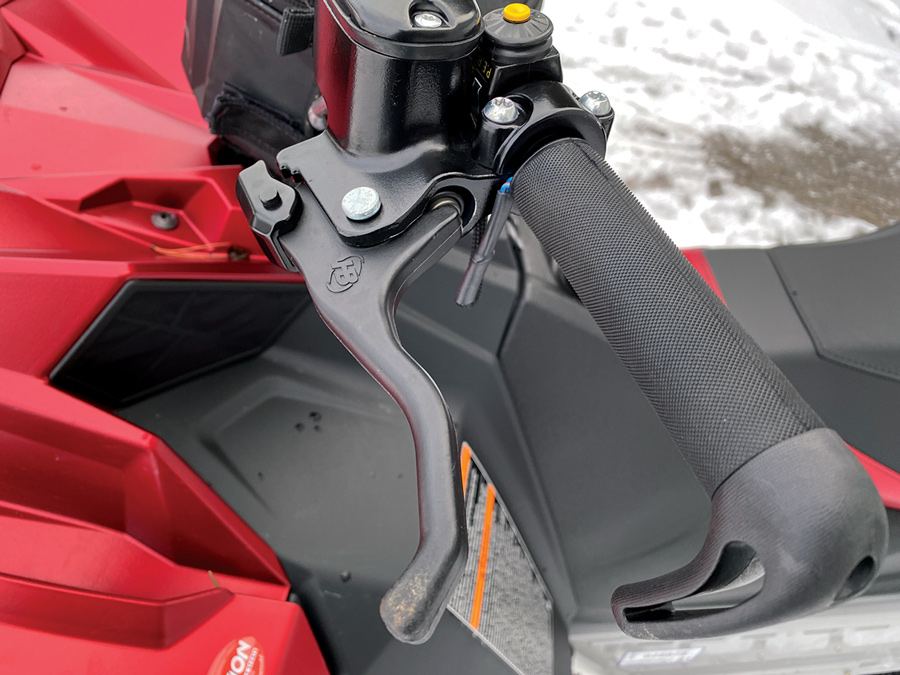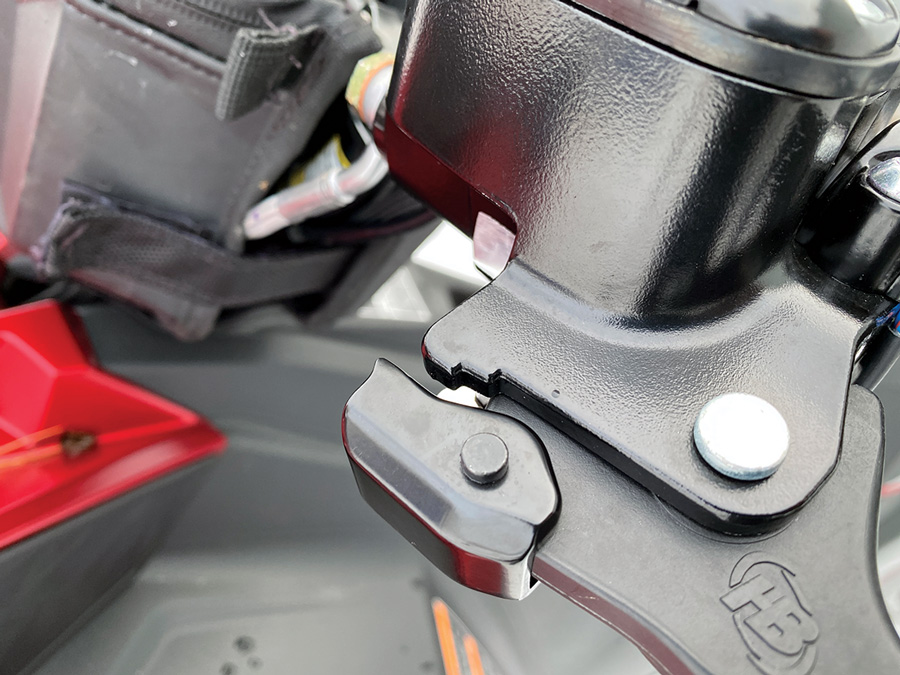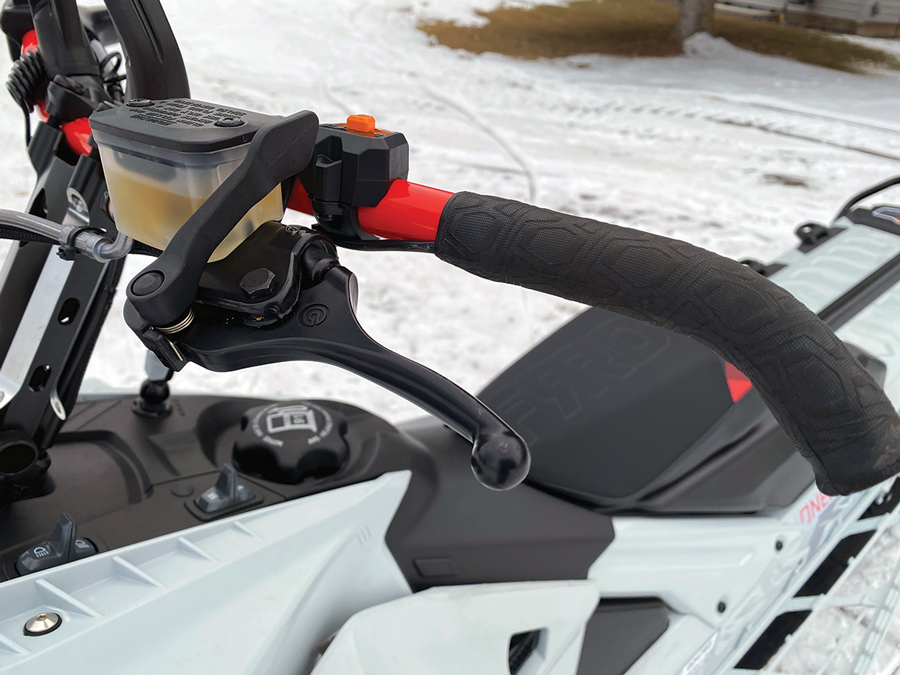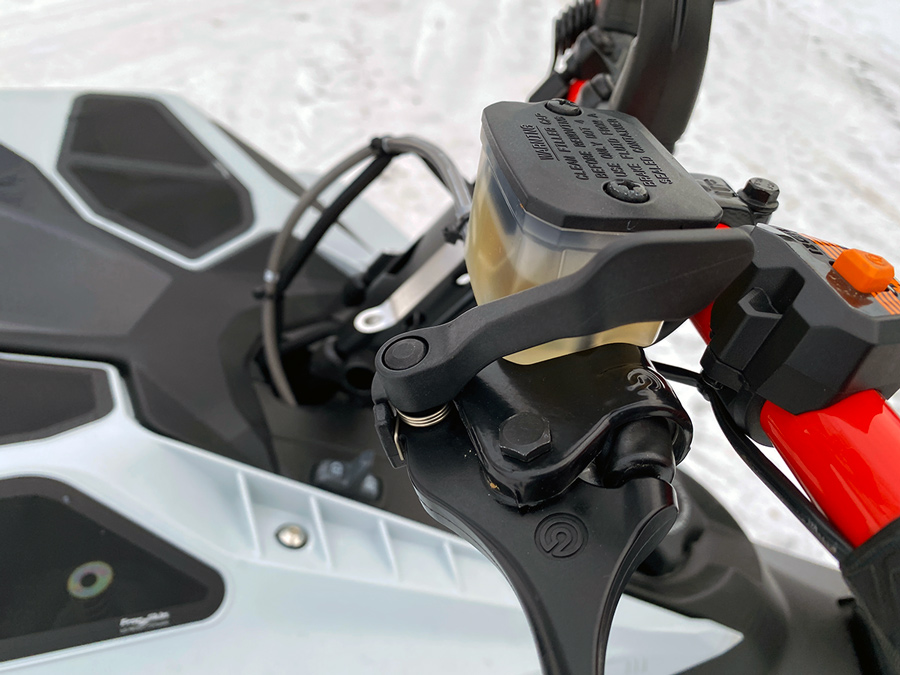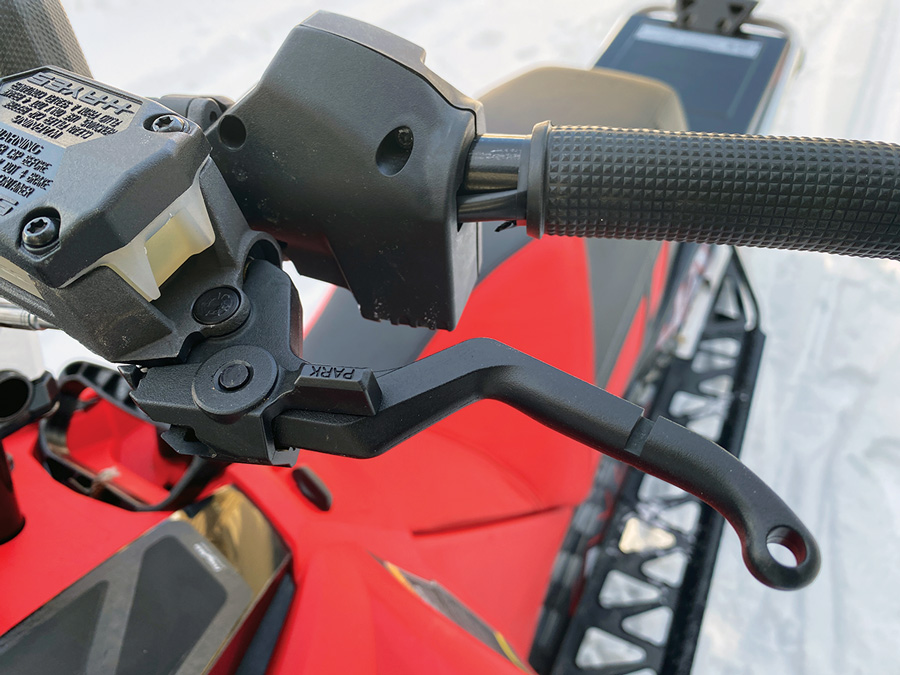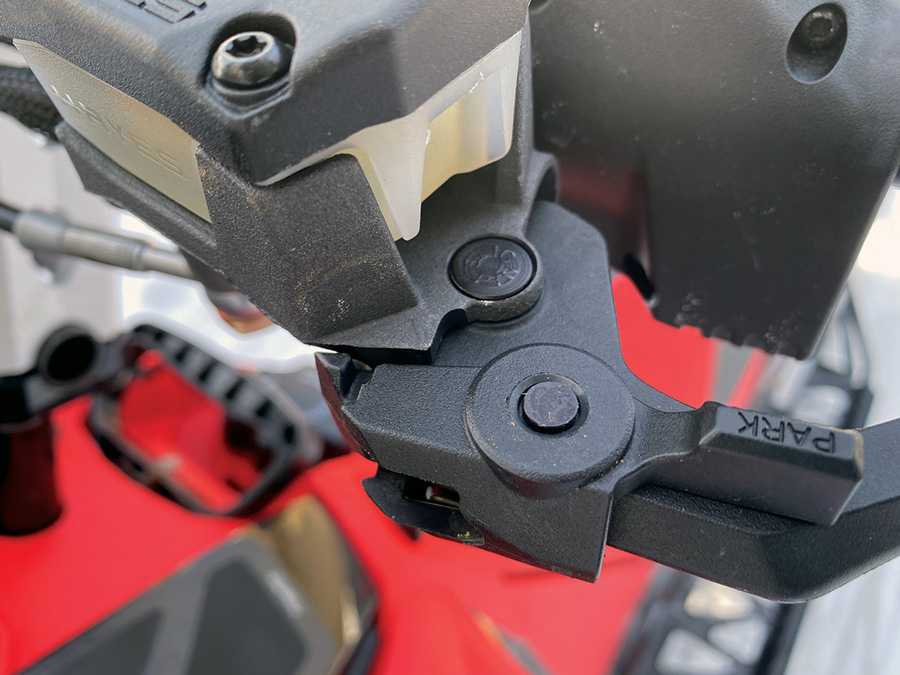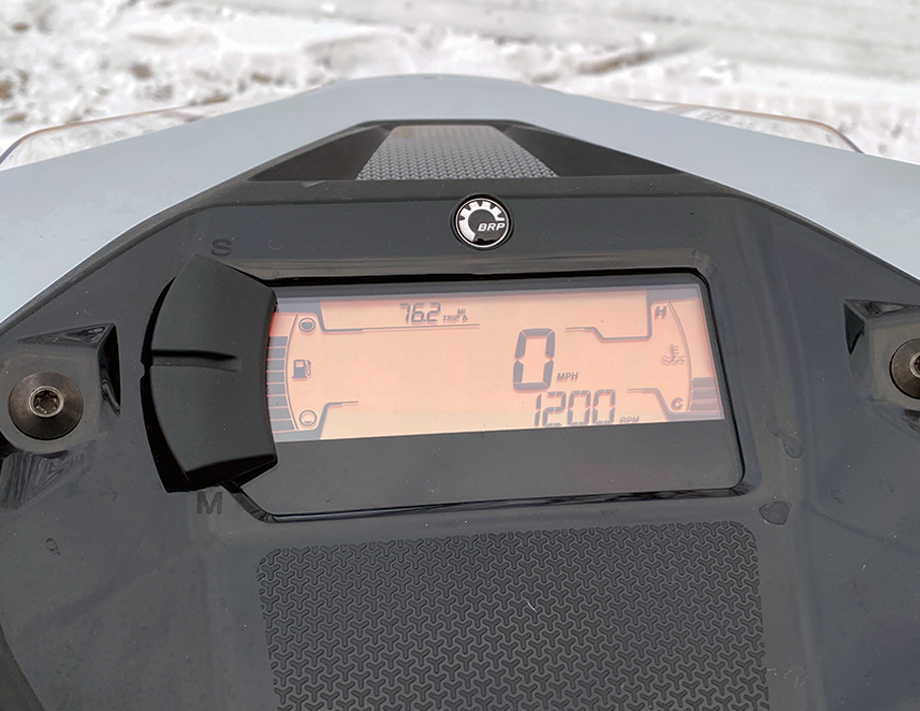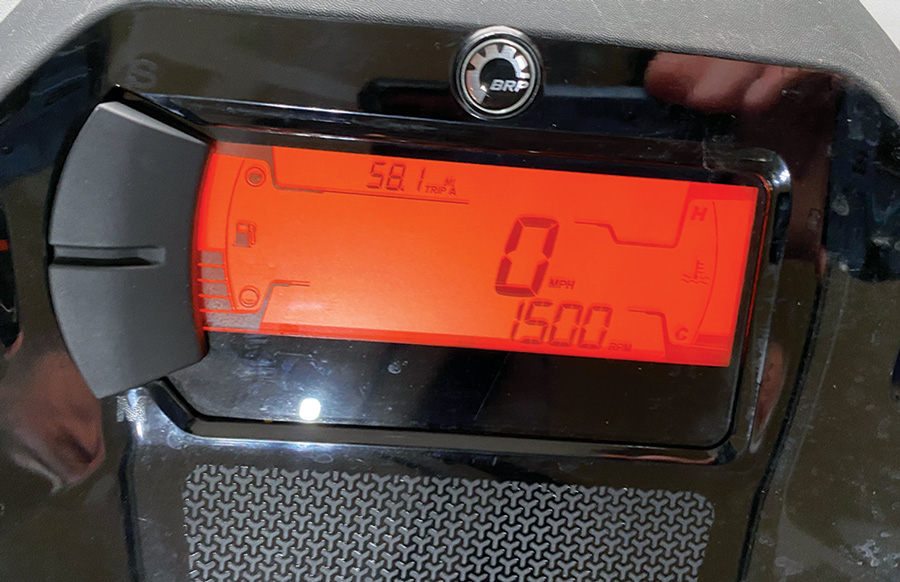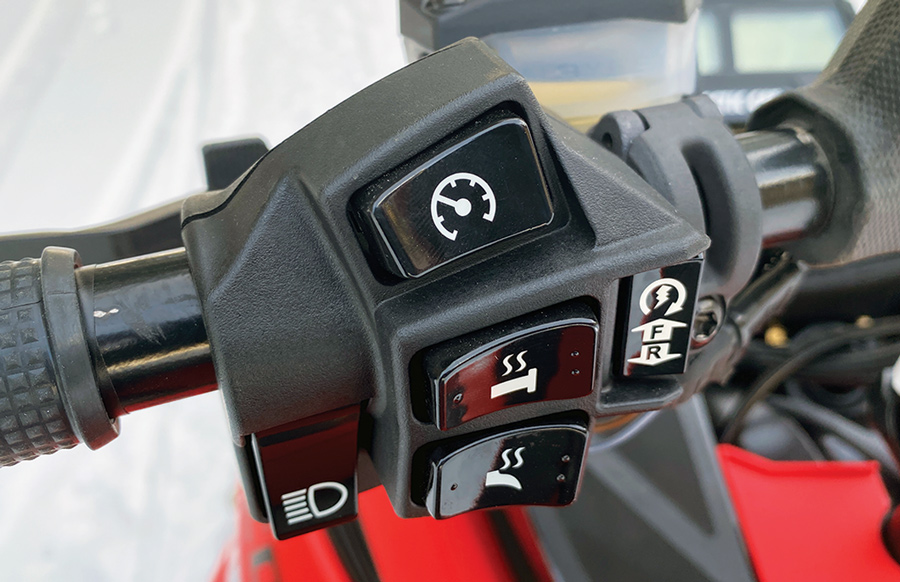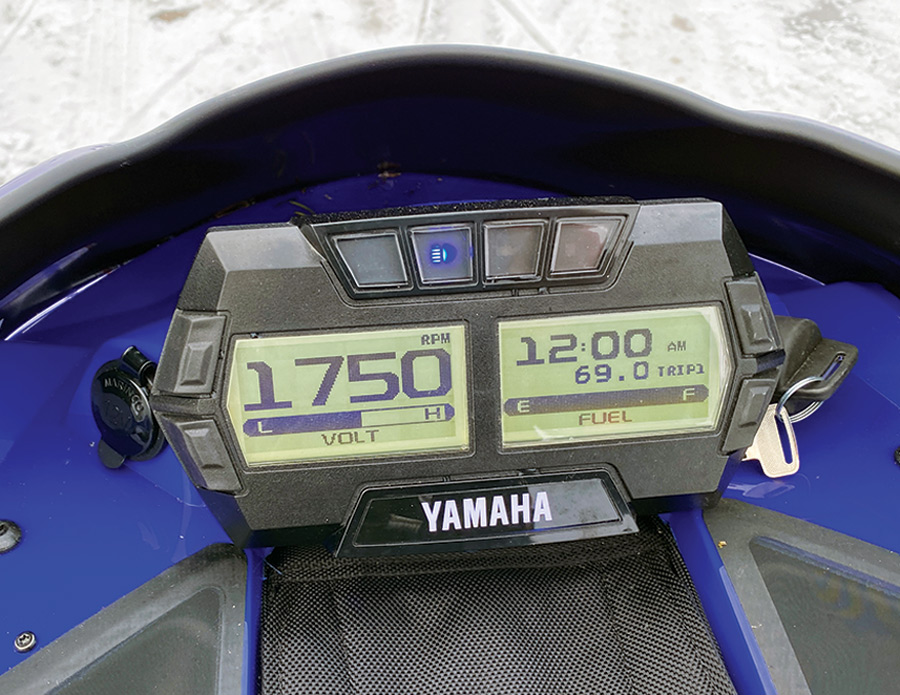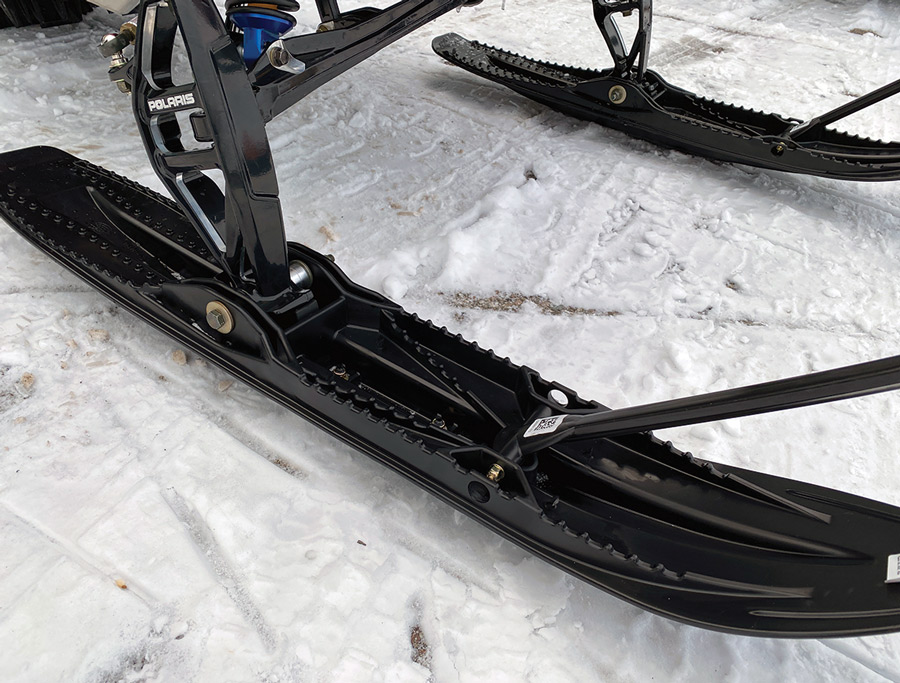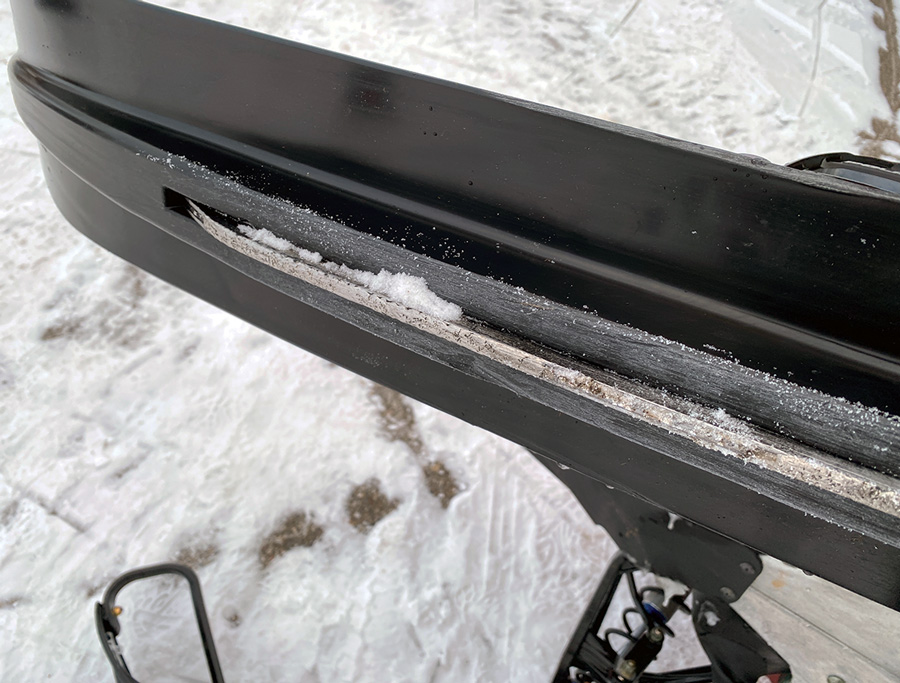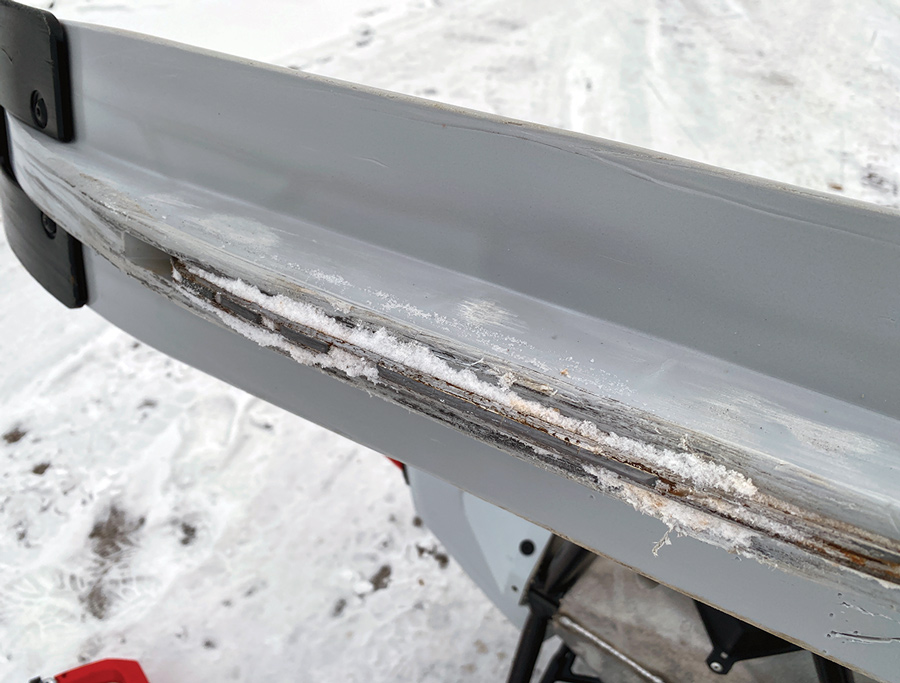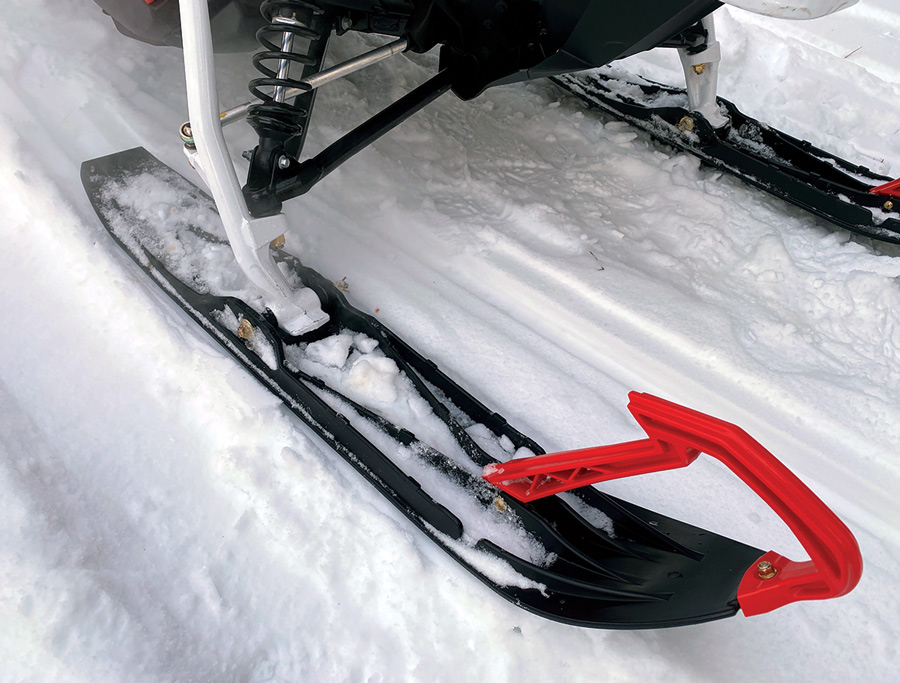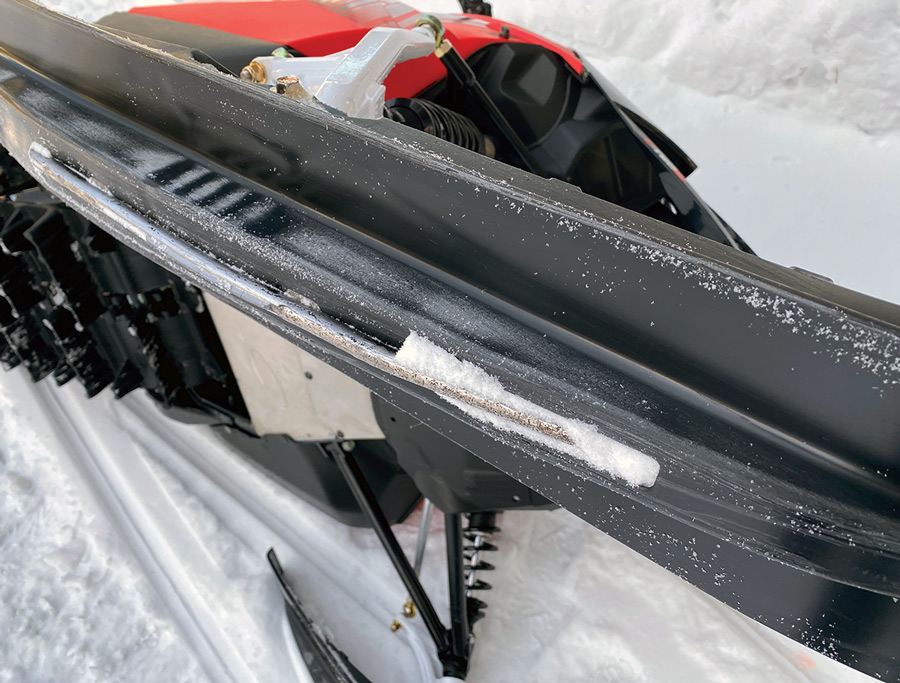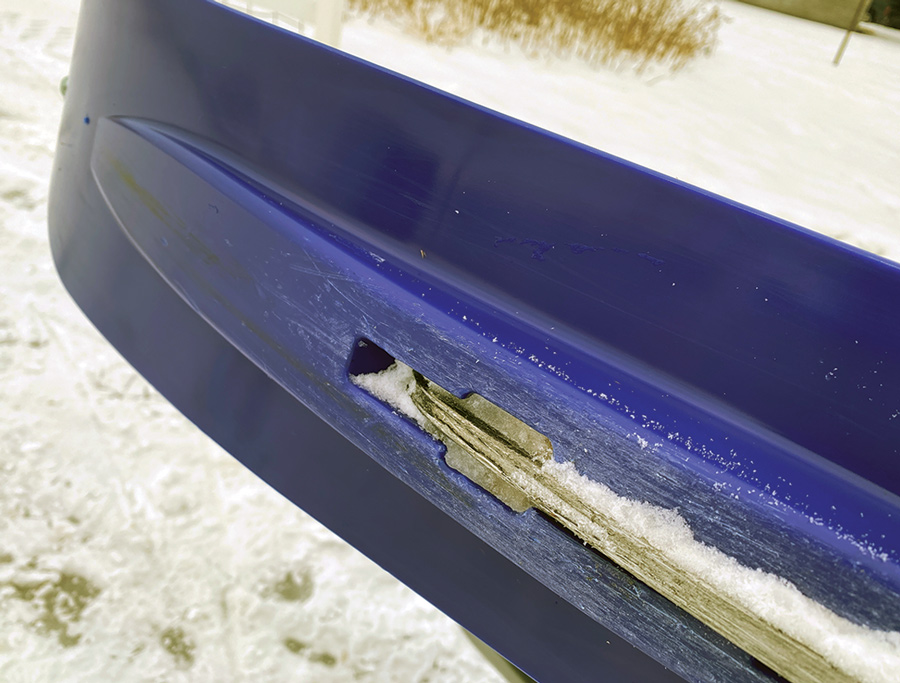


It’s all about the math. Some like more, some like less—more power, less weight. How about more suspension, more durability, more track, more track speed, more paddles, less trenching, less effort, less cost and less weight? Sometimes you can’t have both more and less. You have to decide your priorities according to your riding style.
During the 2021 SnoWest Deep Powder Challenge, the one thing that did add up was the awesome power delivered by the Ski-Doo Summit X Turbo that caused our test riders to take note.
Some may question the fairness of a turbo competing with naturally aspirated snowmobiles. Well, if your snowmobile comes stock from the factory with a turbo, it’s still a stock sled. And there’s no question that it was the best snowmobile on the mountain during our deep snow event.
The most common response from the test riders when bouncing from sled to sled was: “Wow. I knew it would have more power. But I had no idea it would have that much more power and would be that easy to ride.”
We actually tried to break our tests down into two groups of snowmobiles—165s and 154/155s. We had the following sleds available to test: Ski-Doo Summit X Turbo 165, Polaris Khaos 165, Arctic Cat Mountain Cat Alpha One, Arctic Cat Hardcore 154, Yamaha Mountain Max 154, Polaris Khaos 155 and Ski-Doo Freeride 154.
Although there are other models of mountain sleds, these sleds represented a cross section of what we think are the best features from the four manufacturers.
As you read through this article and the sidebars with charts, photos and quotes, you will see a lot of subjectivity in sorting through the information. That’s always the most challenging aspect of any head-to-head snowmobile comparisons. Part of the reason we offer so much variety in our information is to allow you to sort through and pick out what’s more important to your riding preference. Sometimes power isn’t as big a factor as handling, weight or price.
Although brand familiarity will always play a factor for our test riders when it comes to handling and sidehilling, sometimes spending more time on a snowmobile they’re not familiar with opens their eyes to things they’ve been missing.
Obviously, the endless power of the Summit Turbo stood out in the deep snow just southwest of Two Top in Island Park, ID. Snow conditions created the type of challenge that would push most sleds to their limits.
We picked a great day for testing. A recent snowstorm had dumped a couple feet of dry powder. There really wasn’t much of a base below the fresh snow, so even though the weekend warriors tracked up all the new snow on the flat and open terrain, hardly any ventured out into the trees where the going was really tough (occasionally we would see the craters left by those who ventured off the beaten path … they really looked like war zones with multiple stuck holes located within feet of each other and deep enough to bury armies). The snow had received a couple days of sunlight which left a slight crust on the top layer that was very conducive to trenching.
In these conditions, you have to have a snowmobile that’s easy to throw on line, light enough to stay high in the snow, an aggressive track to keep forward thrust, and enough power to generate track speed to maintain forward momentum—and all of this without hitting trees.
With the expert riders, all the snowmobiles carved through the trees and clawed their way up the slopes. However, with the power of the Summit X Turbo, there was never any question as to whether you could make a climb.
Both Ski-Doos, the Turbo and the Freeride, showed a little more bottom end power. The Polaris Khaos sleds were perhaps the weakest on the bottom (that could be due to track lug size—2.75 inches). Although the Cat engine delivered a lot of power, it seemed to be the first to run out of power on the top end. All the sleds were very comparable on the midrange (if you exclude the Turbo).
One thing that made the Turbo impressive was that it didn’t get in its own way at low speeds. You’re not having it try to spool up and generate boost. It rides just like any other stocker with smooth bottom-end grunt. The explosive power is only there when you ask for it. And even then it comes in smooth and controllable.
When it comes to counter-steering, the Arctic Cat and Yamaha (with the single-beam rear skid) were extremely easy to engage and control. As for that dreaded right hand sidehill/turn, the Alpha One suspension engages instantly on the counter-steer and will tip the snowmobile into the slope with very little effort.
As for the Khaos, this sled was always true to its line. The consensus of the test riders was that with Polaris you could set your edge and the snowmobile would maintain it, even when cutting through the ruts and trenches left from other snowmobiles. Cat and Yamaha also proved to be predictable in holding a line. Polaris, Cat and Yamaha seemed to have similar balance points and predictability during a sidehill.
With the Ski-Doos, the riders who don’t have a lot of seat time on the Rev Gen4 chassis were constantly correcting their line. Often the uphill ski would pop out of the snow and try to level out with the other ski. This would cause the sled to either drift uphill or dive downhill. So foot placement on all the sleds generated a lot of the nuances in handling. Just an inch forward or backward could change the balance plane of the sled. However, even those riders who spend a lot of time riding Ski-Doo have accepted that the snowmobile is going to be light on the front and require a little extra work to maintain its line.

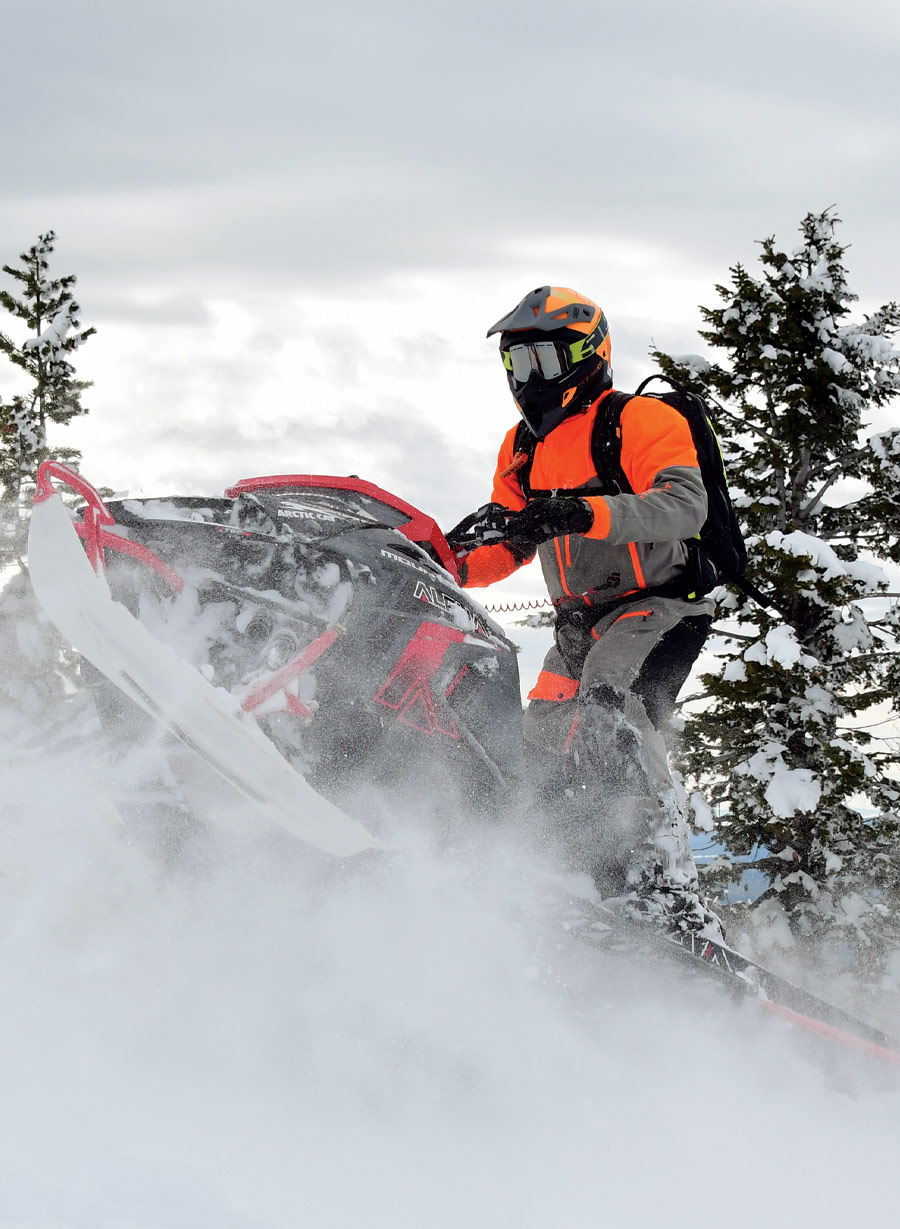


Another issue that separates the mountain sleds is with front-end balance. Although you want the nose to lift up out of the snow, you don’t want the sled coming up too high for you. This was a constant struggle with the Ski-Doos. We were constantly burping the throttle or tapping the brake to keep the front end level.
However, when running through trees, it is much easier to stay neutral (feet on each side of the running boards) and travel at slower speeds for control on the Ski-Doos.
For the Alpha One sleds, there tends to be a balance point where you’re on the throttle and the front end lifts up and planes smoothly, or you let off the throttle and the nose dives and you feel a lot of front-end weight.
With Polaris, the big difference between the Pro RMK and the Khaos is how the two pivot in the snow. The Pro stays level. Polaris designed the Khaos to be a little more playful to allow the front end to come up higher. The result is you have a snowmobile that stays relatively level but with a playful front end. (That’s one of the reasons we chose the Khaos over the Pro for the Deep Powder Challenge.)
Also, the 165-inch tracks showed much better flotation … although the test riders found that the 154/155 length tracks proved to be much more playful and quicker to respond in the turns.
When it comes to forward thrust, all of the long tracks tend to do a great job. However, when it comes to track length and lug depth, our test riders were all over the board on their likes and dislikes. For some, the longest and deepest were always the bestest. Others felt the 154/155s provided better track speed, were much more playful and could still go through the deep snow. There also were disagreements on the lug depth. Some felt the shorter lugs trenched less and thus kept the snowmobile more level in the snow.
The 3-inch Power Claw track hooked up hard and worked great in most snow conditions. It tended to thrust hard forward and allow the snowmobile to get on top of the snow a little easier. The 2.6-inch Power Claw seemed to trench a little too much in the powder. But it worked great on packed snow.
Keep in mind, on the Alpha One skid, the Power Claw track molds to the contour of the terrain. So it will hook up harder since it has a more secure footprint. But it does have a tendency to push forward … not to where your skis are pointed but in the direction the track is pointed.
Although Polaris has gone to a 2.75-inch lug on its Series 8 tracks, you don’t see much loss of forward thrust. In fact, this track tends to trench less and climb up on top of the snow a little quicker.
Both the Hardcore and Mountain Max had a great feel on the trail. The two things we picked up on were that their seats were much softer and their ride was slightly higher. When you went into corners these sleds stayed flat and cornered better than the competition.
Both Polaris and Ski-Doo have fairly stiff seats and tend to show a slight chassis roll when going through turns.
Of our four shorter track sleds, only the Khaos was a pull start. Cat and Yamaha had electric start (which is part of the reason they were also about 80 pounds heavier than the Khaos). The Freeride comes with SHOT, which means you only pull the rope at the beginning of the day and the button for the rest of the ride.
Cat and Yamaha also offered the most user-friendly access to the gauge controls and hand warmers. The gauge is easy to read but takes some time to learn how to adjust and toggle through the information. The little pouch between the handlebars and gauge is perfect for a pair of goggles or gloves. The engine heat kept things warm and de-fogged.

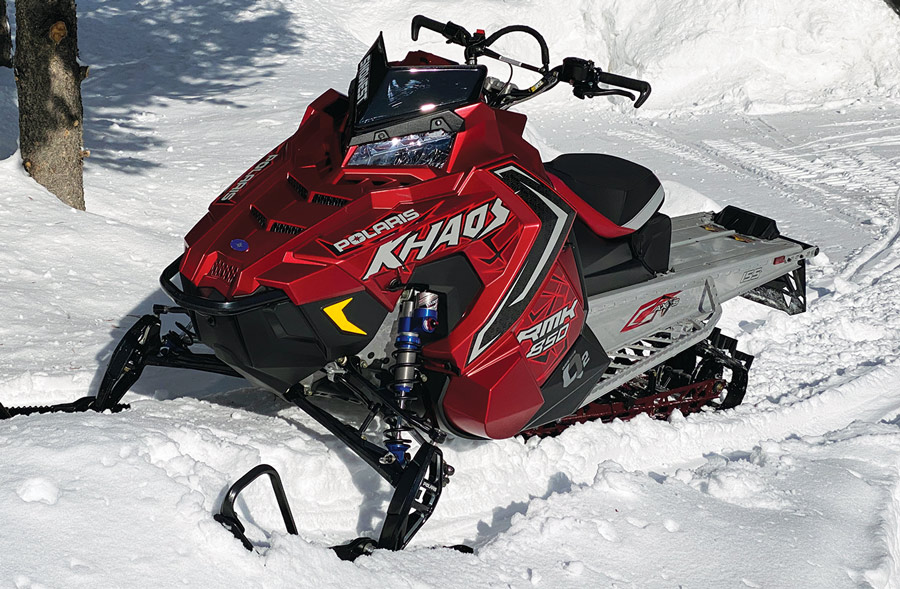
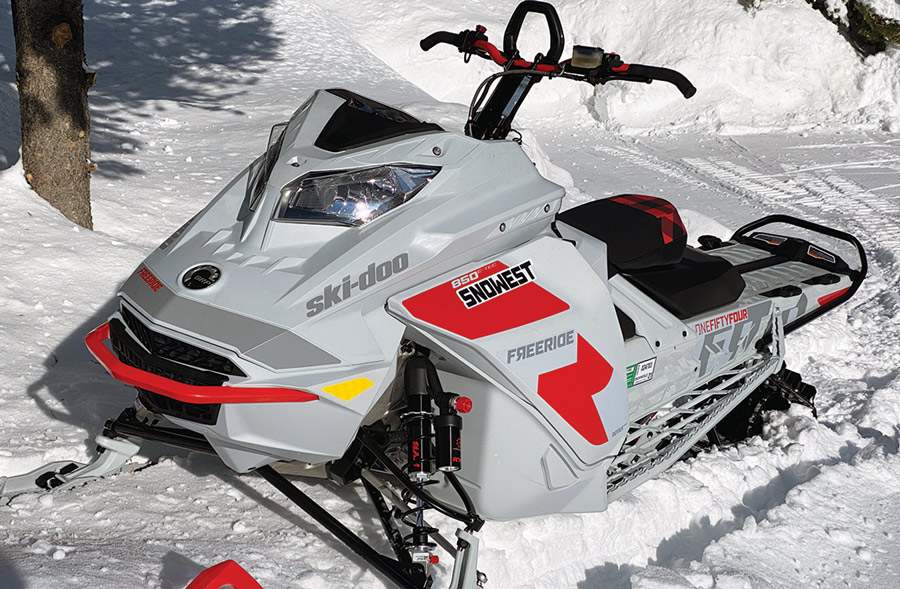
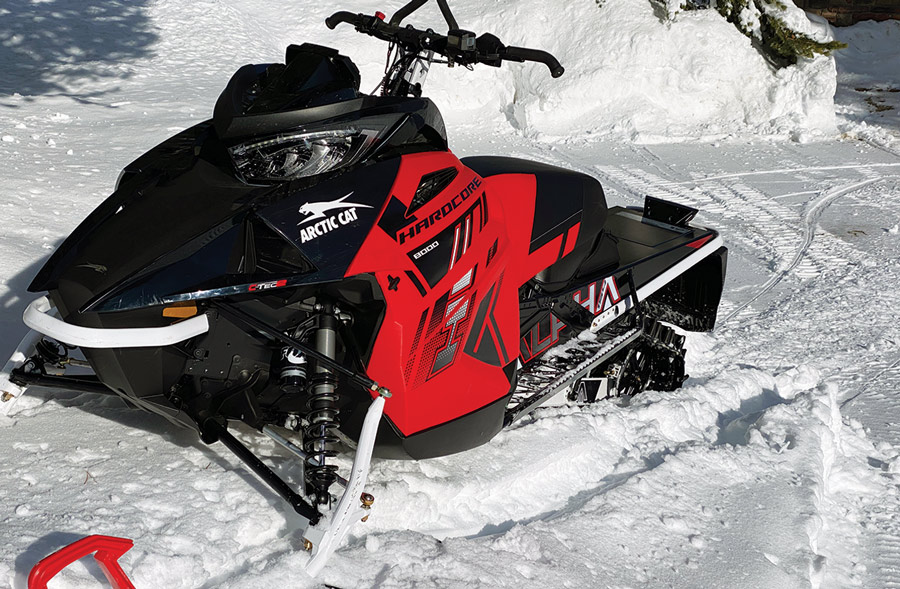
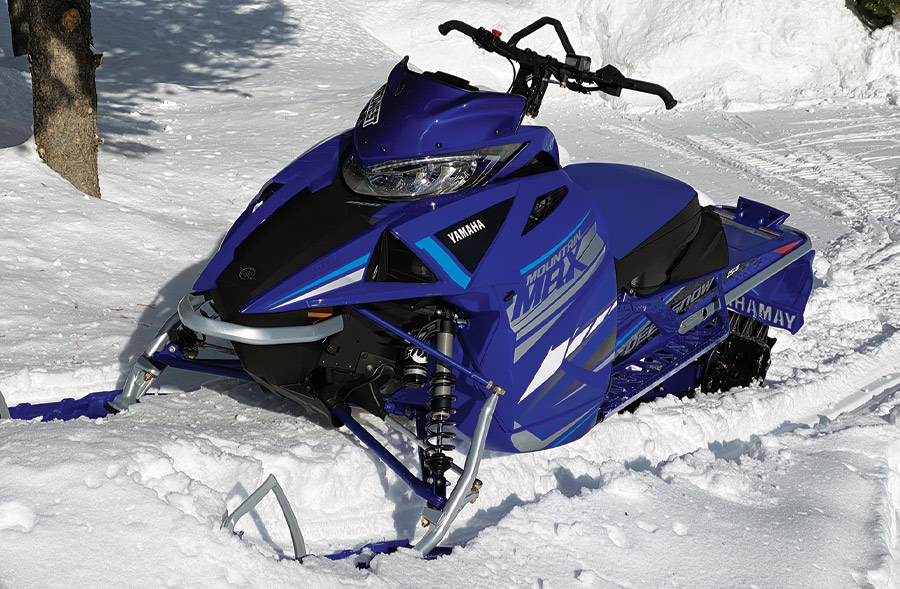
Here are just a few more observations we noted on the sleds:
Ski-Doo, Yamaha and Arctic Cat have reverse beeper. On the Polaris you have to wait for the gauge to re-start and then look for a blinking light.
The mono-beam suspension cleans out better than the other two models. This means you aren’t packing nearly as much snow in your suspension as you do on Polaris and Ski-Doo (this helps compensate for the weight disparity).
We found the Khaos 155 had a tighter turning radius. Both in a slow circle and a hard counter-steer turn, it was 4.5 feet tighter than the Freeride and nearly five feet tighter than the Hardcore and Mountain Max.
In our acceleration tests, the Freeride was faster out of the hole but there was virtually no difference between the sleds after the first 50 yards.
On the 165 tracks, the gap between the lugs were 7 inches for Polaris and Ski-Doo and 7.5 inches for Arctic Cat.
On the 154/155 tracks, both the Ski-Doo and Polaris lugs were spaced at 7 inches while the Hardcore and Mountain Max track spacing alternated between 3 and 6 inches depending on the placement of the finger lugs spaced within the normal gaps.
Polaris is the skinniest sled on the snow. The widest point of the running boards on the Khaos is 28 inches. The Hardcore and Mountain Max are 31 inches wide and the Freeride is 32 inches wide (that’s likely why it gets pushed out of its sidehill in steep terrain).
When you have to lift on the rear bumper, it’s nice to have a good place for your hands. Ski-Doo offers full access to its bumper. It is also the tallest at 31.5 inches off the level. The Cat and Yamaha bumpers are 29 inches high but have a restricted area for grip. Polaris is 27 inches high and features a slight grip restriction to prevent the snow flap from pinching against the bumper. Also, you don’t want to lift from the center of the Polaris bumper; the carbon fiber tube will break if there’s too much weight put in the middle.
Of all the brakes, Cat and Yamaha feature the most responsive. It takes less pressure to engage (a one-finger pull). Ski-Doo isn’t far behind. Polaris does require a lot more pressure to engage so the brake doesn’t feel as responsive.
Although you can always get more power, more suspension, more durability and more track, sometimes you want less weight, less effort or even less expense in finding the snowmobile just right for you. We did the testing … now it’s time for you to do the math.
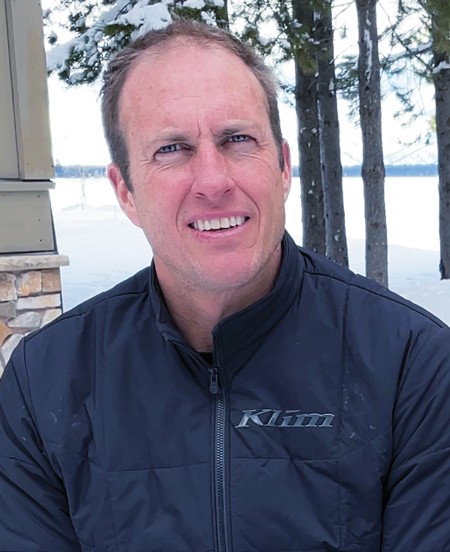
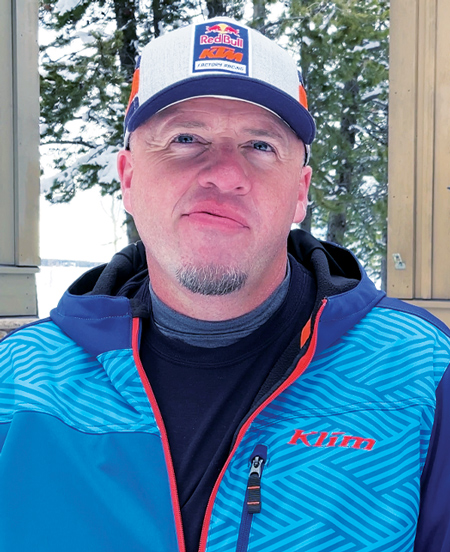
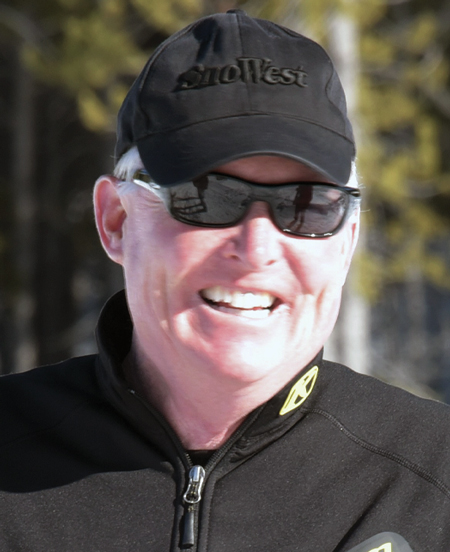

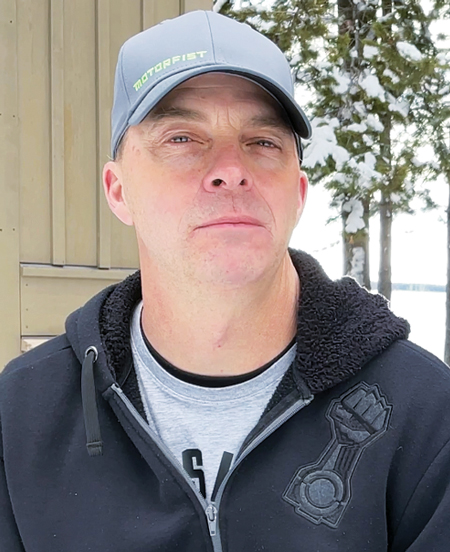

“Cat always has a strong motor and the track always hooks up well no matter what the conditions. Even with some of the conditions we were in today, it was still able to hook up and dig its way out.” — JS
“The Cat feels like its chassis is on a fulcrum. It has a pivot point. If you’re on the throttle and the weight is transferred back, it’s really controllable. It’s really rideable and predictable. But the second I let off the throttle and everything shifts forward, you feel like you tipped forward on that fulcrum and the nose becomes unpredictable.” — RH
“You can make the tightest turns with the Alpha, in my opinion. The Alpha just spins around really fast.” — BP
“I wasn’t worried about getting stuck or not making it to the top (of the slope) on the Khaos. It pulls as well as any stock sled I’ve ridden.” — BP
“The first thing I noticed about the Khaos was how skinny it was. It felt narrow … which I really liked. The Khaos handles well and is predictable. You can tell it where to go and it just goes. It’s probably one of the better balanced sleds.” — BK
“The Khaos is definitely lightened up from Pro. I prefer the Khaos over the Pro because the Pro stays a little too level. It’s totally predictable. I like the Khaos because it’s more entertaining to ride. It’s almost as predictable as the Pro and does a lot of the same things, but it’s a little more responsive and will pop up out of the snow a lot easier.” — RH
“The Freeride runs strong. I think they got the clutching matched to the motor because it runs well and pulls hard from bottom end to top.” — BK
“The Freeride is a great sled. For the most part I like the Ski-Doo feel. It’s just a nice, well-built sled. But it doesn’t have the power that the Turbo has, but you always have a lot of power. The Ski-Doos feel lighter so they seem quicker and easier to turn.” — JS
“The best part of the Freeride is the suspension. You can push it and jump it and run it hard down the trail through the bumps.” — RC
“I feel like Ski-Doo had everything dialed in. The powerband felt smooth all the way through. It pulled hard from bottom all the way through to the top end.” — BK
“The Yamaha runs great. It has a strong motor. It runs clean and smooth.” — RC
“Obviously anything we say about the Arctic Cat Hardcore can apply to Yamaha since the two models share most of their parts. But it’s great to see that big blue sled powering up slopes and holding tight to sidehills. The four-stroke sleds from years past were awesome for those who preferred that kind of power distribution. But these two-stroke models just might get Yamaha back into the game in the Western market.” — SJ
“With the Khaos my skis were always about six inches off the snow. With the Turbo, if I wanted to I could have flipped it over backwards.” — BP
“When riding in standing position, you really feel more upright on the Yamaha and Arctic Cat sleds. It’s surprising how that one more inch of distance between the running boards and the handlebars allows you to straighten out a little bit more. This also tends to give you a more natural roll as you lean into the corners; perhaps that is also added by the mono-beam rear suspension that allows more flex in the track from side to side.” — SJ
“The handling on the Ski-Doos is much different than on the other sleds. They are nice and light on the front end, but they also dance a little bit more.” — JS
“I do like the way the Alpha One grips the snow. And when you’re on the throttle, the Alpha One is probably the easiest to turn and pick your line.” — RH
“Going downhill, the Polaris was really controlled; I didn’t have to change my line at all. With the lay-down steering on the Ski-Doo I felt I was having to change my steering a lot just to keep a straight line. It wasn’t as predictable as the other snowmobiles.” — BP
“To me the Cat always felt a little heavier, especially when you let off the throttle. You have to plan your lines a little bit different to give you time to maneuver.” — JS
“The Ski-Doo is kind of a finesse sled. You don’t put a lot of effort into it. You can ride it in the neutral position most of the time. On the Arctic Cat and Yamaha, I can’t stay neutral on them. I have to throw them around a little more. On the Polaris, I can stay pretty neutral and initiate turns. But there are still times I have to initiate counter-steer turns to get it where I want to go.” — RH
“Some of these other guys may not be (comfortable on a Ski-Doo) because it reacts a little bit different from the other sleds when you hit a bump or old tracks in the snow. It will kick you a little funny. But that can be due to rider stance. It makes a big difference on where you’re standing on each sled. Just a couple of inches different, forward or back, on each sled may have a big impact on how they are going to react.” — RC
“Once on the snow, the Mountain Max has a very stable platform. You feel balanced and on top of the snowmobile. Riding down the mountain trail it has a good grip to the edges and stays flat in the corners. If you tap your brake, the weight transfer would allow the ski carbides to dig in and hold the turn. You weren’t feeling that front-end roll that you experience on Ski-Doo or Polaris in similar situations. Perhaps it had something to do with the weight just keeping it level.” — SJ
“I liked the running boards of the Freeride. They have that lip on the side. On the Polaris I feel like I’m going to slide off them.” — BK
“The Freeride takes a bigger hit. You can push it harder and it won’t do anything crazy that would kick you off trail. We were riding a little harder through a whooped-out trail and I could push it a little faster through the moguls and the suspension would just absorb it.” — RC
“I love how easy the Khaos is to get it to do what you want. It’s a predictable sled. It’s super easy to tip on its side—sometimes almost too easy. On a technical sidehill, through the trees, you can really slow it down, hold your sidehill and pick your perfect line.” — RC
“The Polaris and Cat seemed to hold a sidehill a little better. The Ski-Doo takes a little more work for me. But the more I rode it, the better I figured things out.” — BK
“The thing I noticed about the Ski-Doo was when going over old tracks. Where the other sleds would just cut through them and soak them up, I felt the Ski-Doo wanted to lay back down onto the two skis. But that could have been rider position.” — BP
“My favorite riding is dropping into a canyon littered with trees, like we did today, and riding the sidehill line through trees where the gaps are fairly big. You can ride fast through the trees, but you’re constantly crossing back and forth through the bottom of the drainage and picking different lines. With the Ski-Doo, I could stay in a neutral position, one foot on each side of the seat, and all I have to do is push my knee in a little bit and move my shoulders and I can get the sled to cut wherever I want.” — RH
“First off, the power isn’t even close. The Turbo has at least 20 more horse up here. When going down and then turning back up, both the Khaos and Turbo did a really tight turn. But the initial power and hookup of the Turbo was the biggest difference. The power of the Turbo is unreal. I didn’t think there would be that big of a difference. We were riding today at 8,000 feet elevation and there was no end to the power of the Turbo.” — BP
“It kind of makes you a little bit giddy inside to grab a handful (of the Summit X Turbo) and listen to the turbo spool. It changes the dynamics of how the sled handles because there is so much power that the skis are kind of irrelevant in deep snow because it lifts the front end out and you can put the sled wherever you want to go.” — JS
“The Summit Turbo puts a smile on your face, for sure. That thing is impressive. It has endless power and you feel confident on it. If I had the money I’d get one today.” — BK
“We got a chance to ride all the different brands today. And power-wise, the Turbo stands out.” — RC
“All of the 154/155 sleds roll into the hill super easy. They are super easy to get on edge and hold the edge. Mountain sleds have come a long way in the last 5-10 years. The steering on the Cat and Yamaha are a little stiffer feeling as far as riding through the trees and going slower. The Polaris has a little bit lighter feel, and the Ski-Doo even lighter than that. The Ski-Doo is super light on ski pressure.” — RC
“The Cat’s track is pretty phenomenal.” — JS
“Depending on the snow, those areas where there is little moisture and a lot of fluff, the longer tracks are the only way to go. In the areas where the snow contains a little more moisture, you can’t beat the 154/155 track lengths. The snow conditions we encountered on the Deep Powder Challenge really called out to the 165s. There really aren’t too many days around here when the snow really wants to just swallow you up.” — SJ
“Of all the mountain sleds, Yamaha and Arctic Cat share the same problem—a strong vibration when idling. If you take off your gloves for just a moment and place them anywhere on the snowmobile while the engine is idling, you will be picking them up out of the snow. The vibration in the bars, however, quickly goes away when you give it gas.” — SJ
“The Freeride is a little squirrelly through the trees. The laid-down steering post is something I’m not used to. The more I rode it, the more used to it I became. It does try to come up on the skis a little too much for my liking.” — BK
“The Ski-Doo tends to have the best of both worlds. But on a downhill descent or steep sidehill, the panels will push the side out and either cause the track to drive out of its trench and fall down the hill or cause the front end to pop out of the snow and try to drive you uphill.” — RH
“Just the overall quality of the Ski-Doo is pretty impressive. I think they really produce a polished product.” — JS
“On the Alpha I don’t dare go fast on a rough trail for fear of breaking my rails. If it’s a rough trail I ride under 20-30 mph. On the Khaos, I was going way faster. It felt like I would have broken my Cat rails had I ridden it that fast.” — BP
“I like that Yamaha has a two-stroke again. I had a chance to ride the four-strokes in the mountains and I kind of like riding something lighter with good power. The track (on the 154) is a good track for broader conditions … but with the snow we were in today it seemed it would dig down a little bit, maybe trench a little bit.” — RC
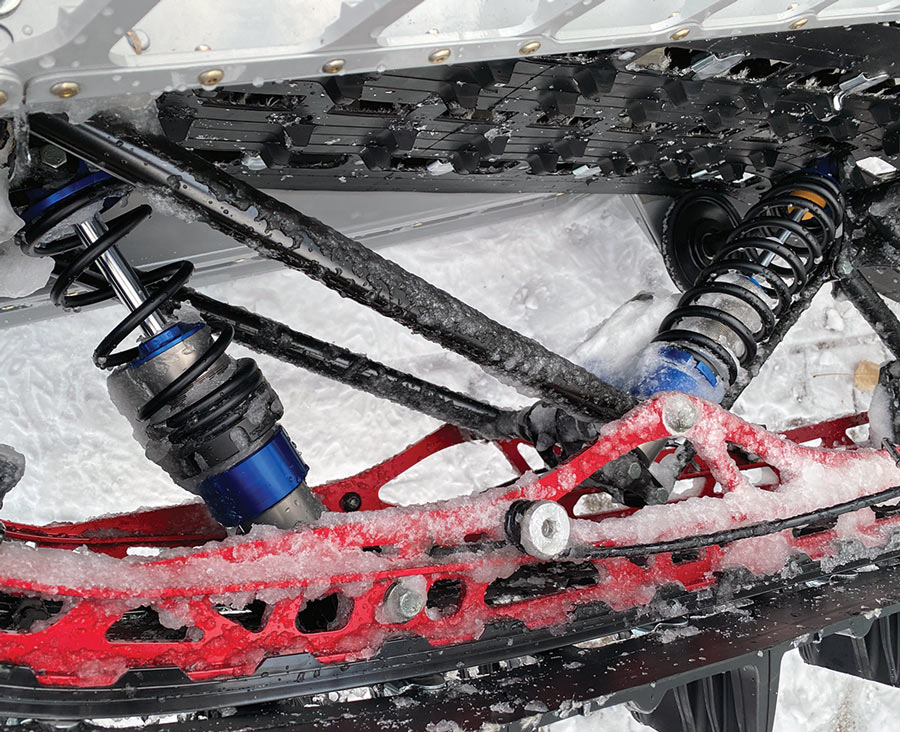
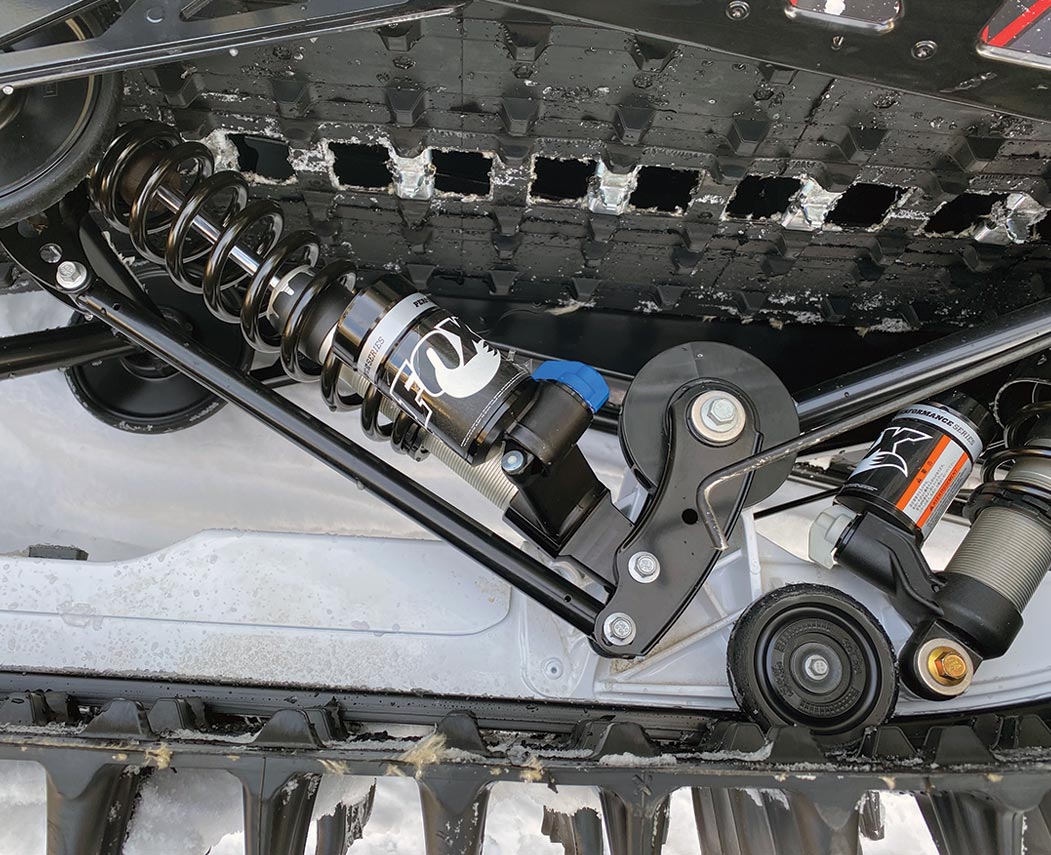







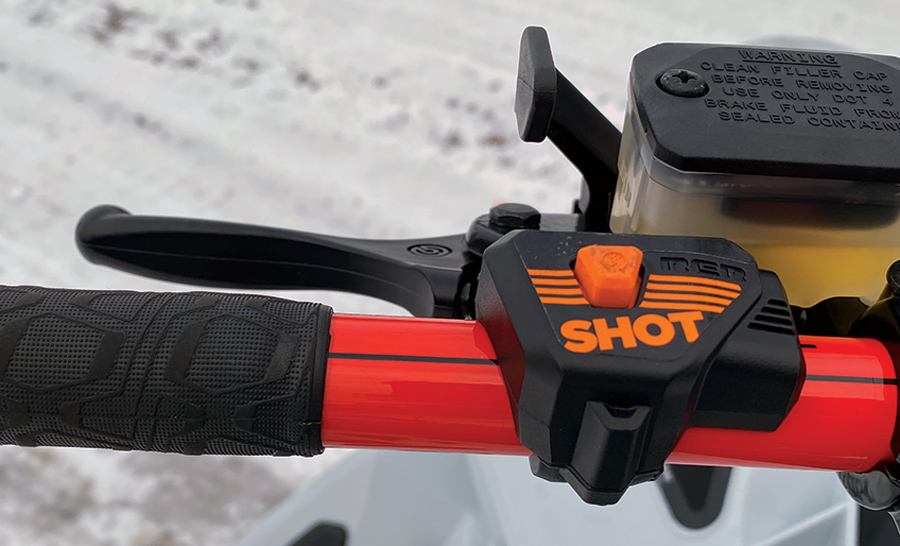

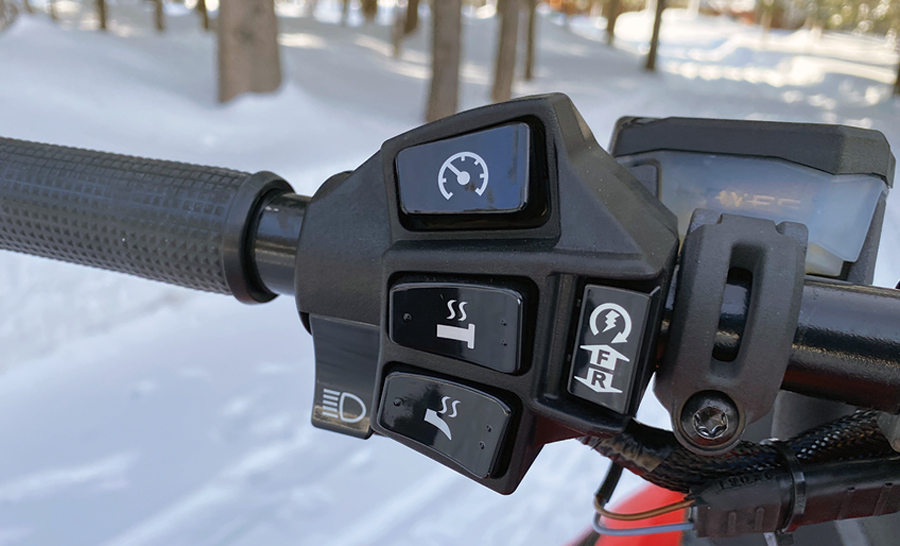

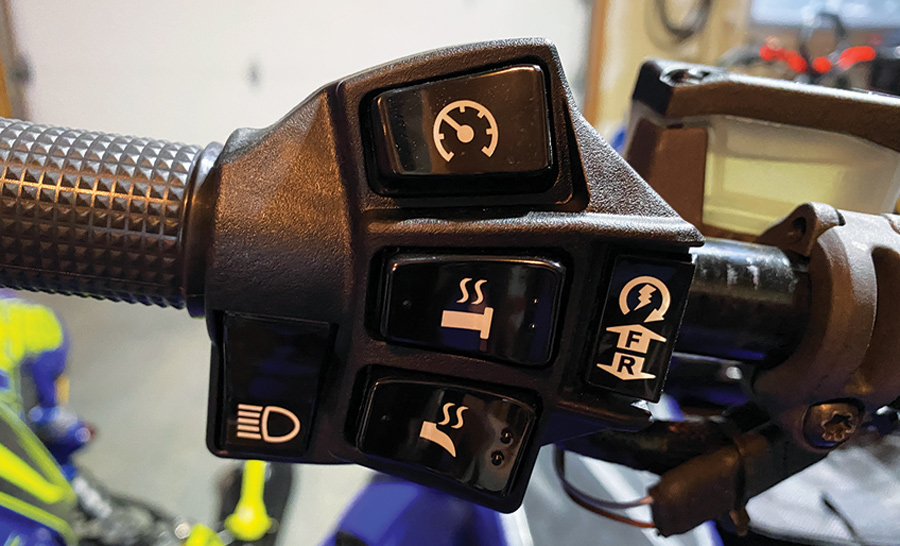

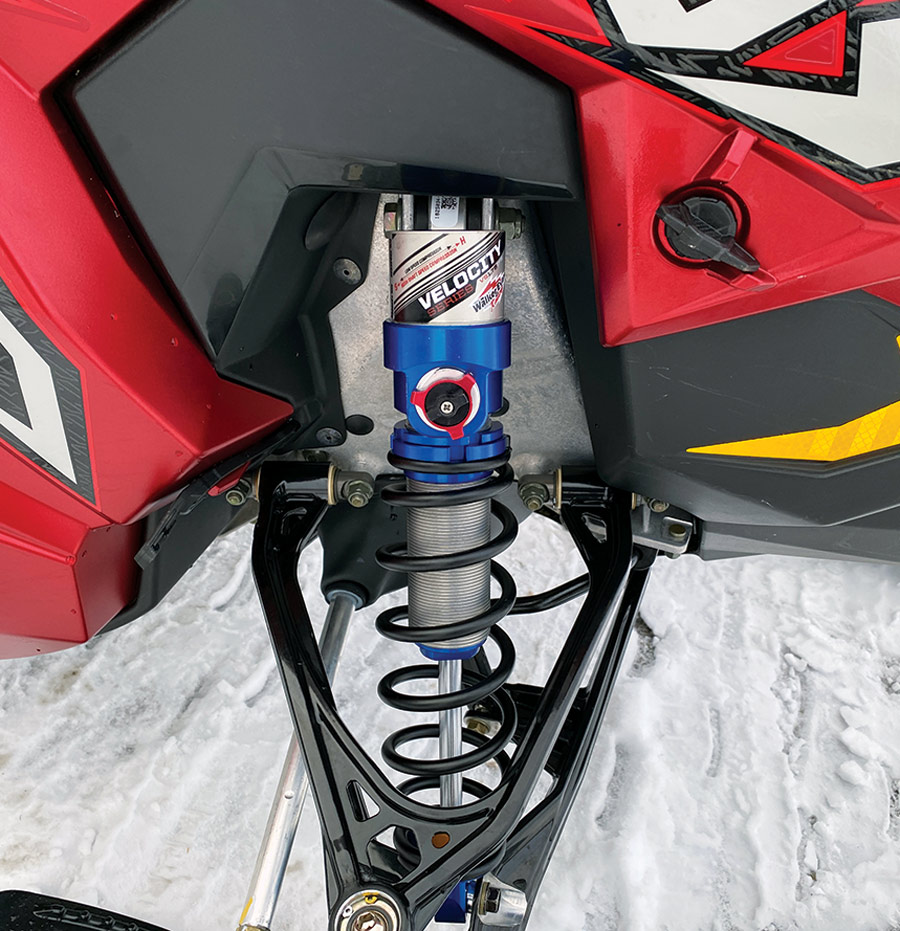


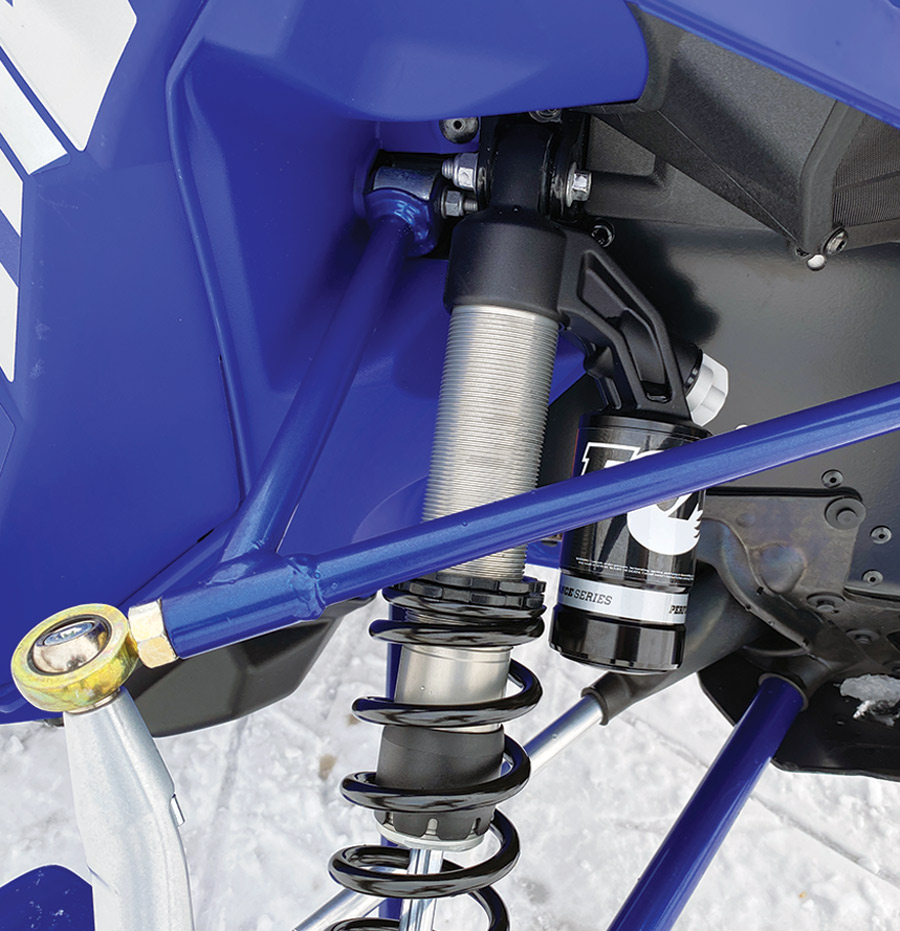
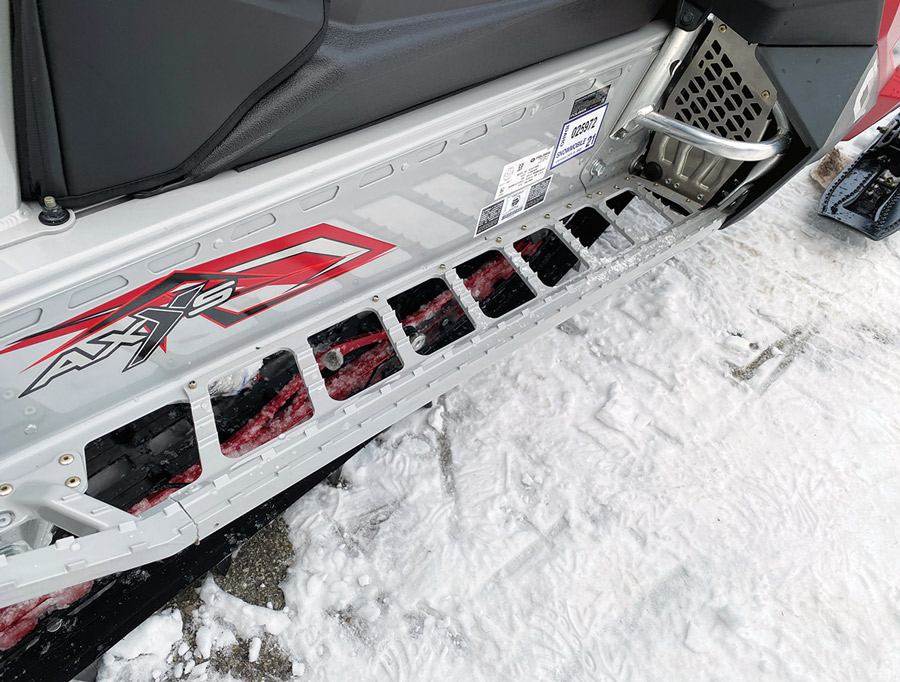
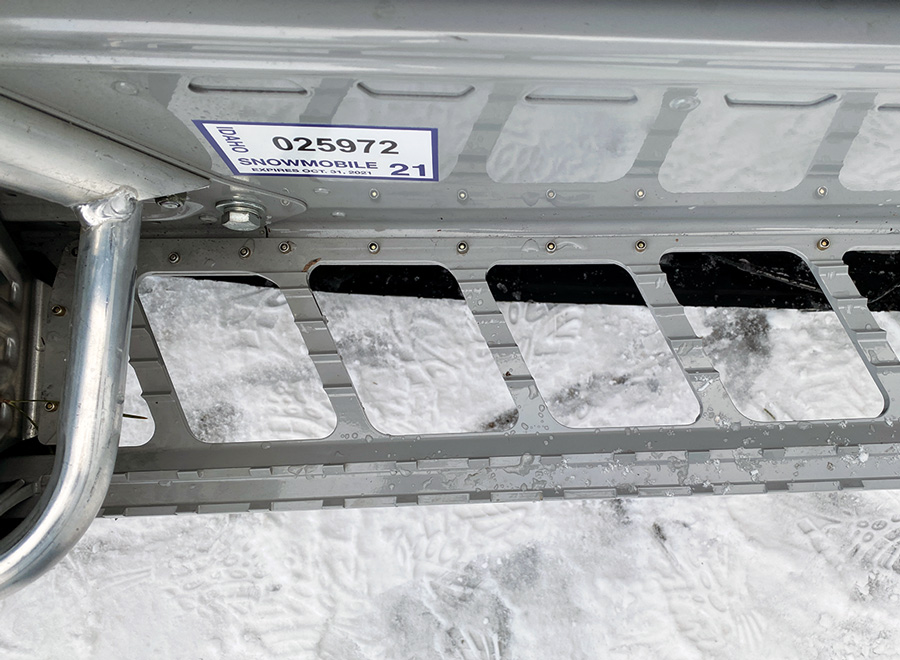
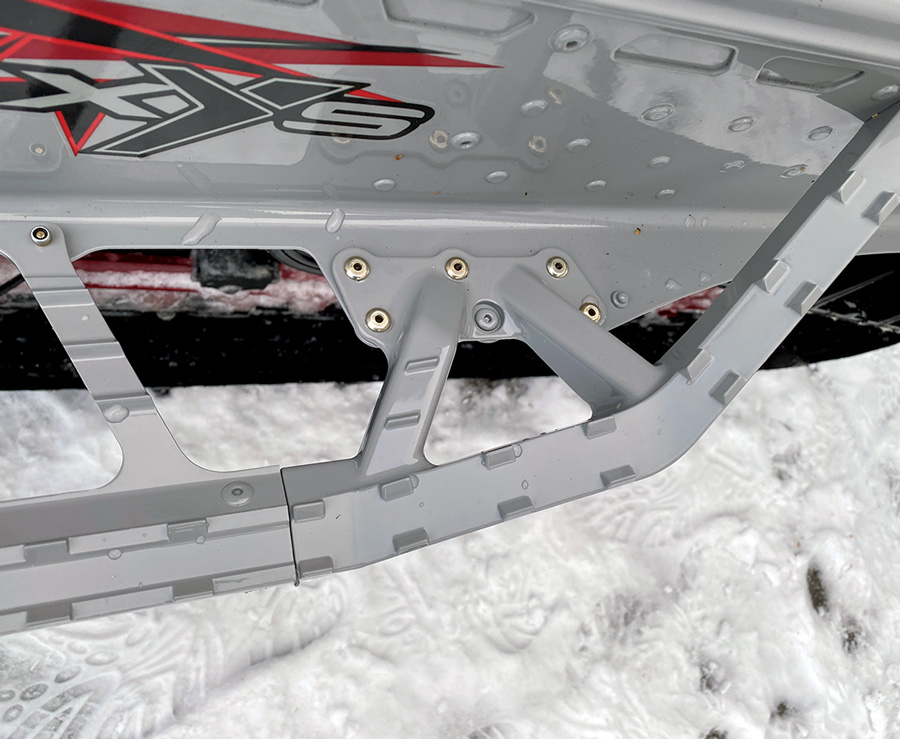
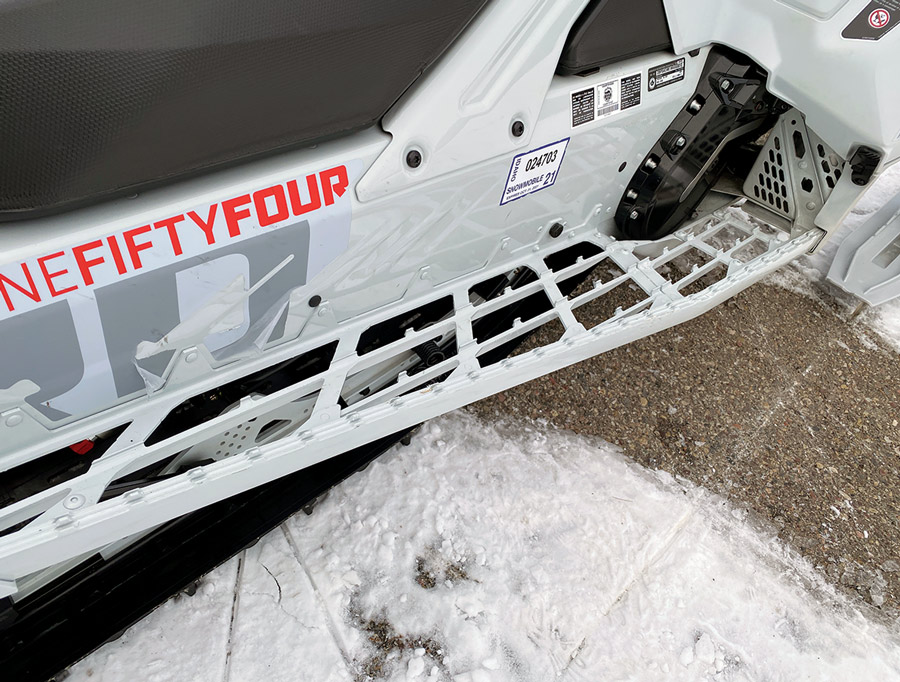

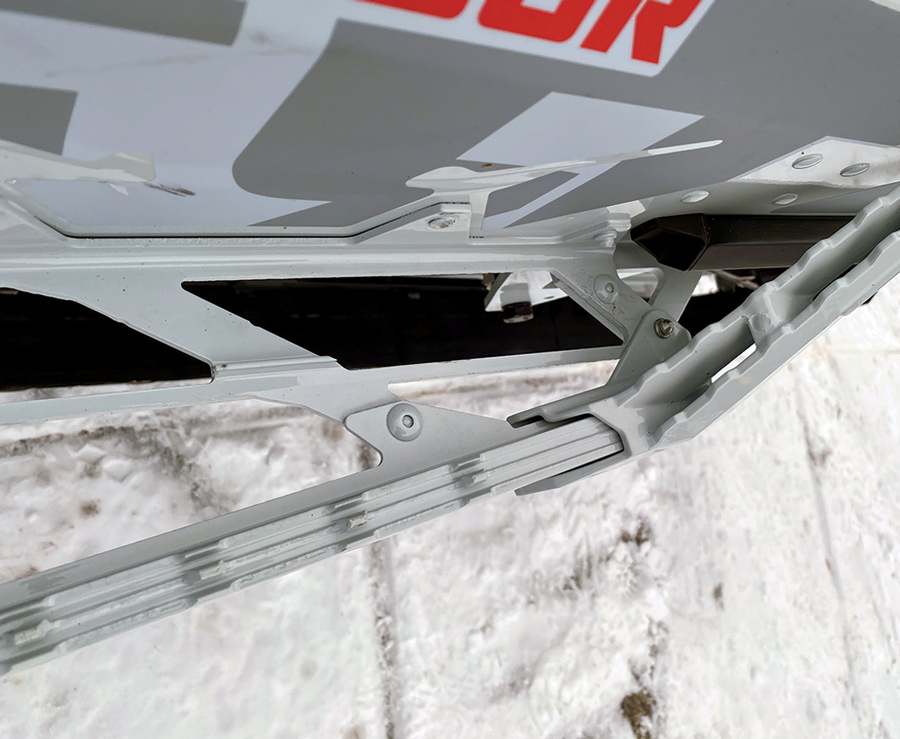
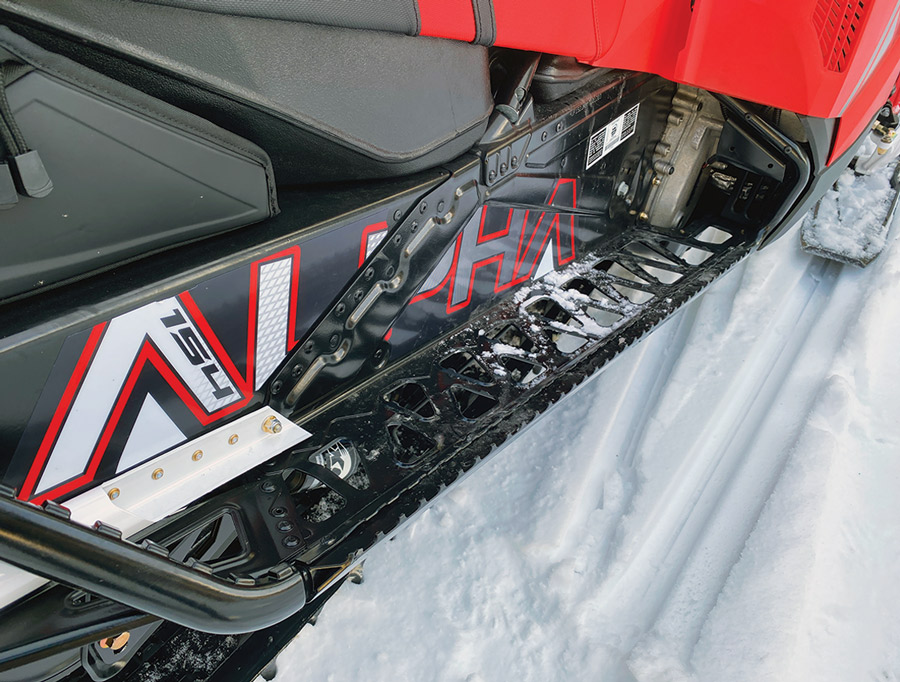
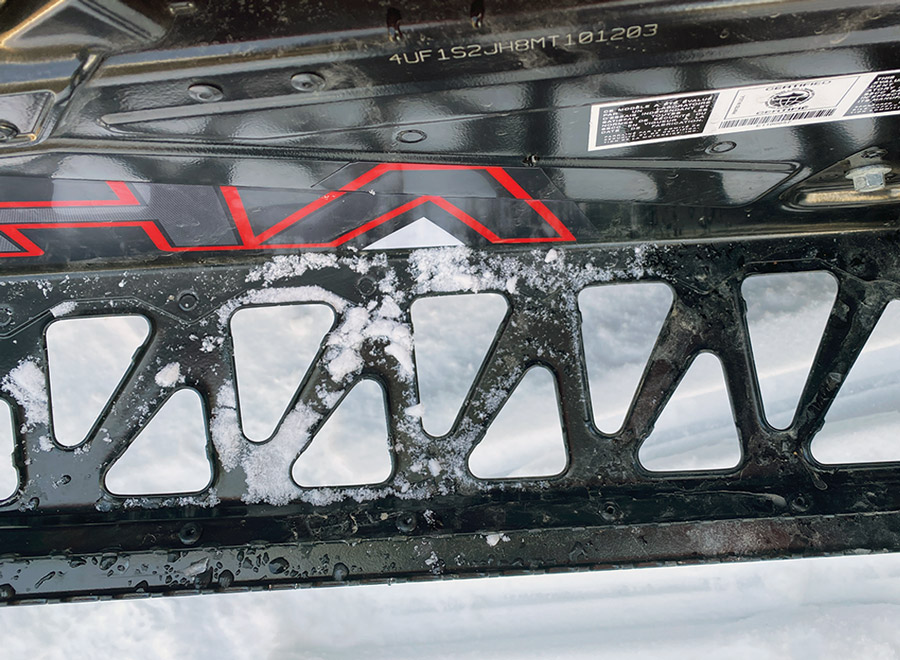

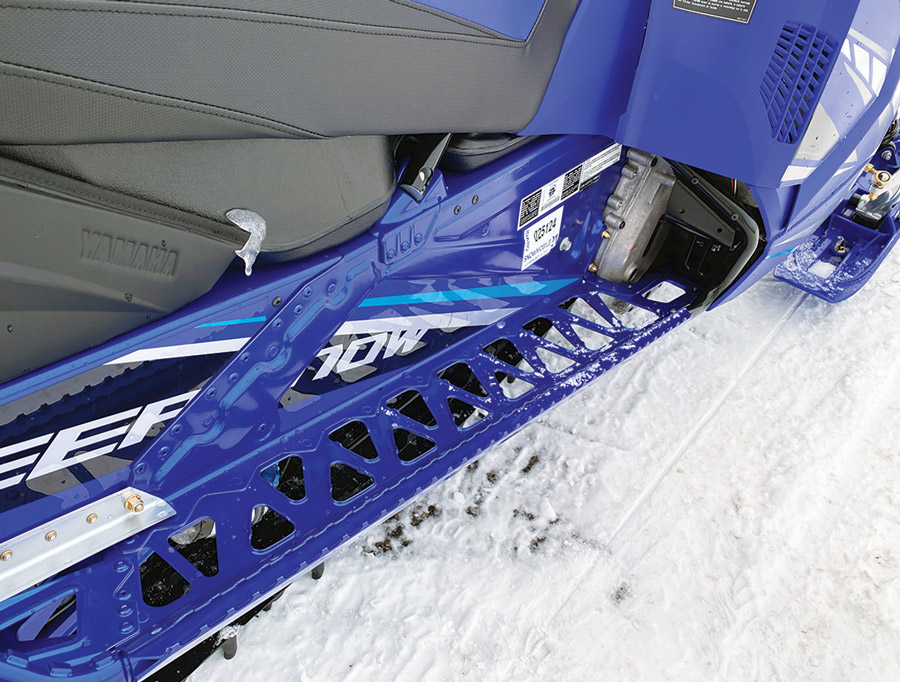

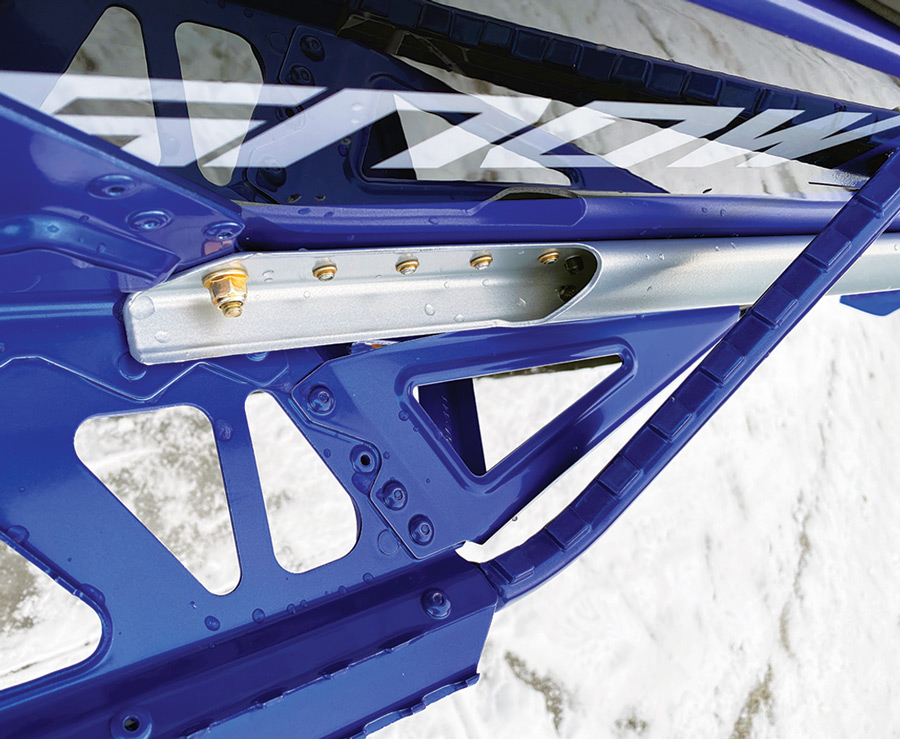
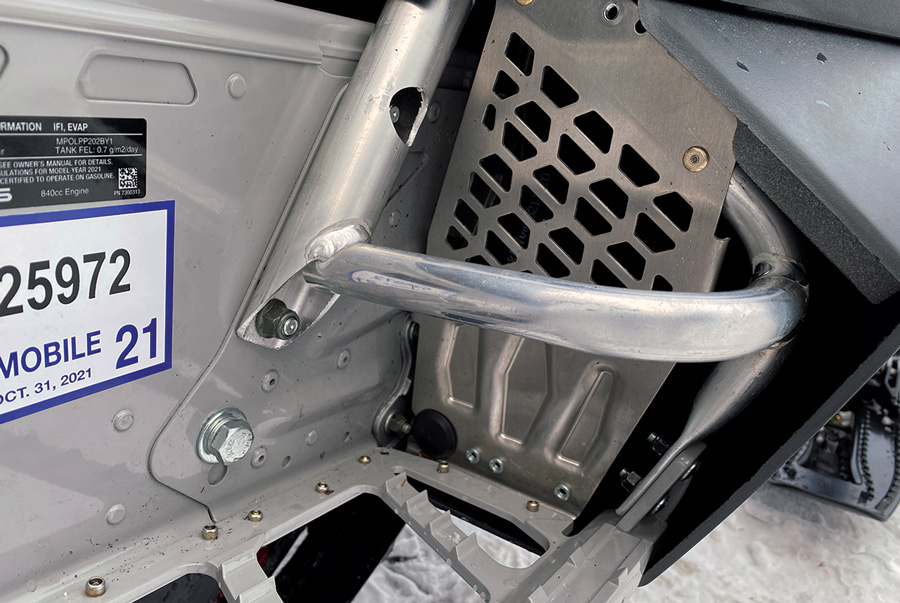
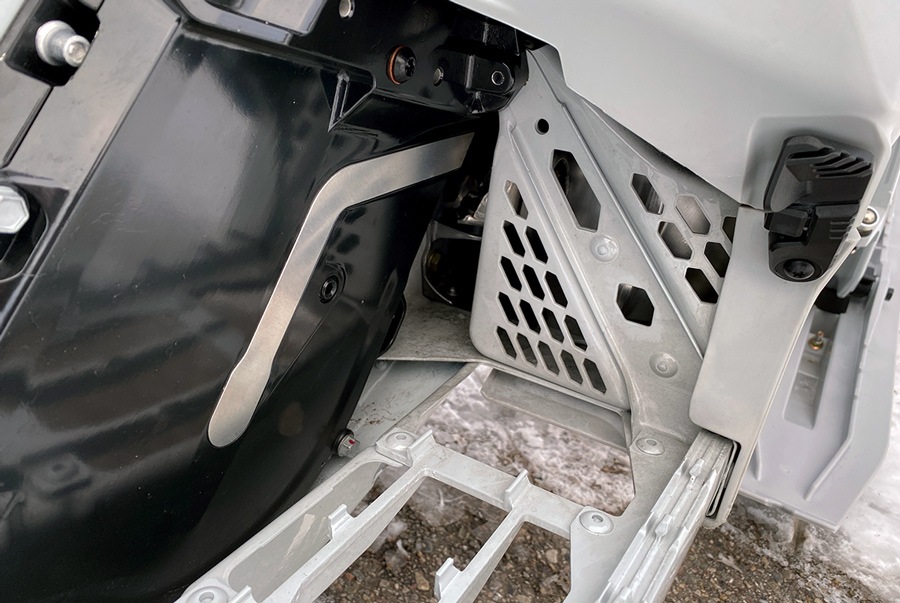
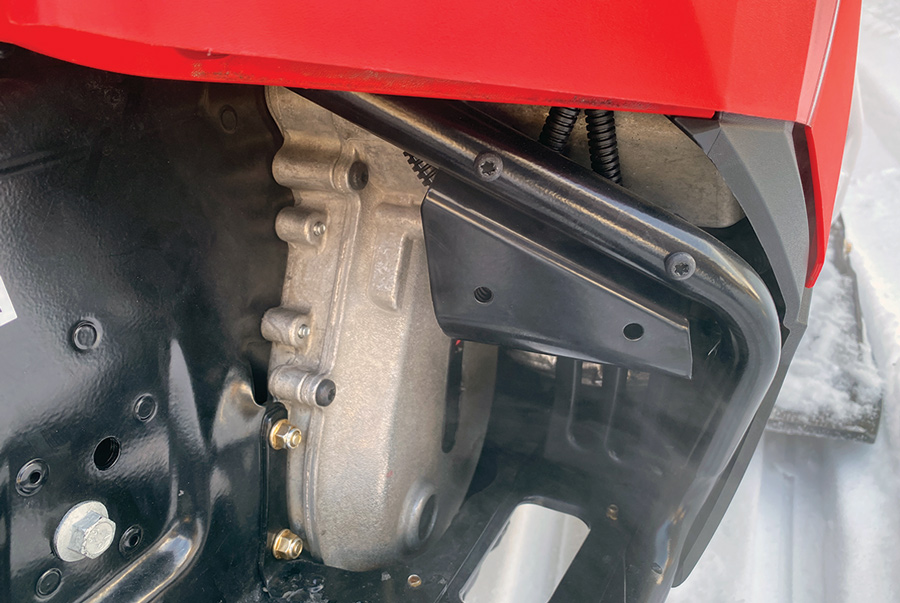
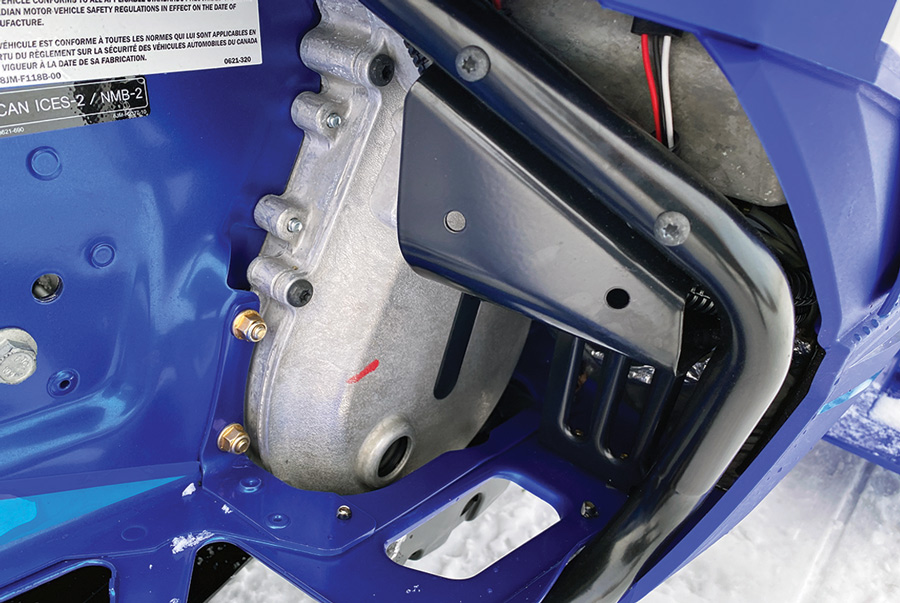
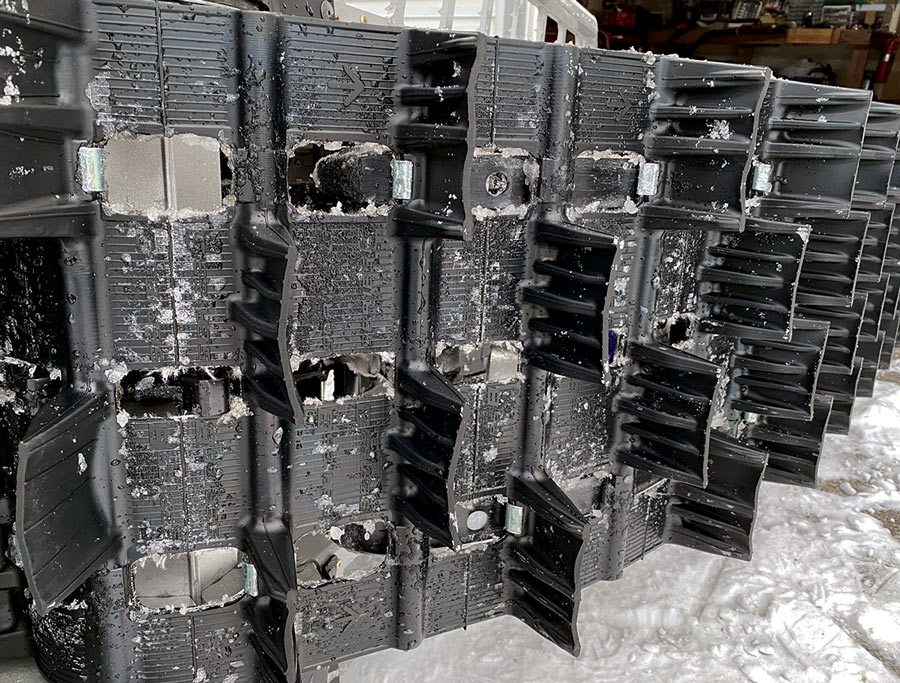
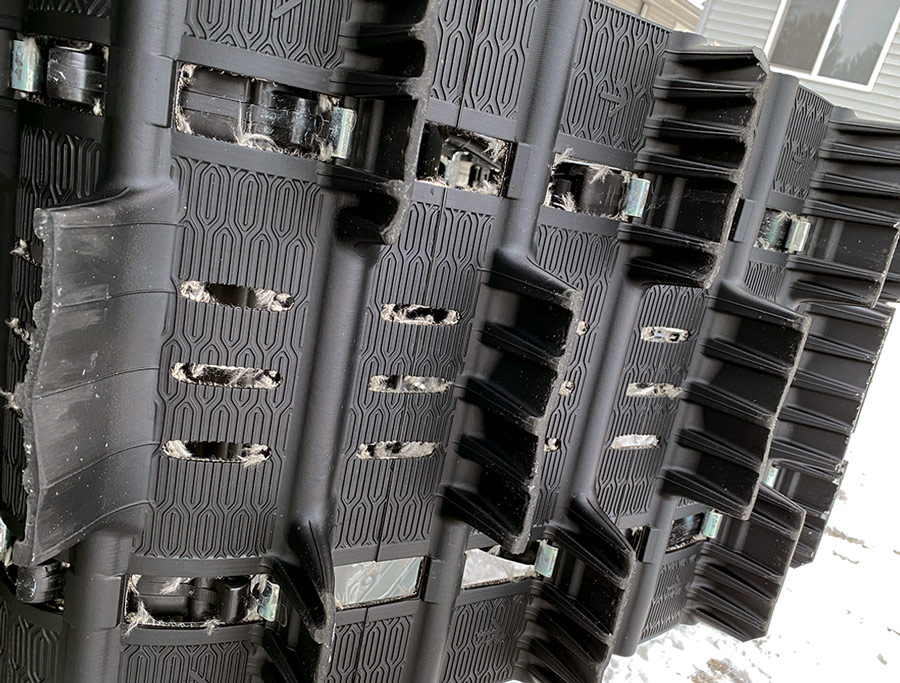


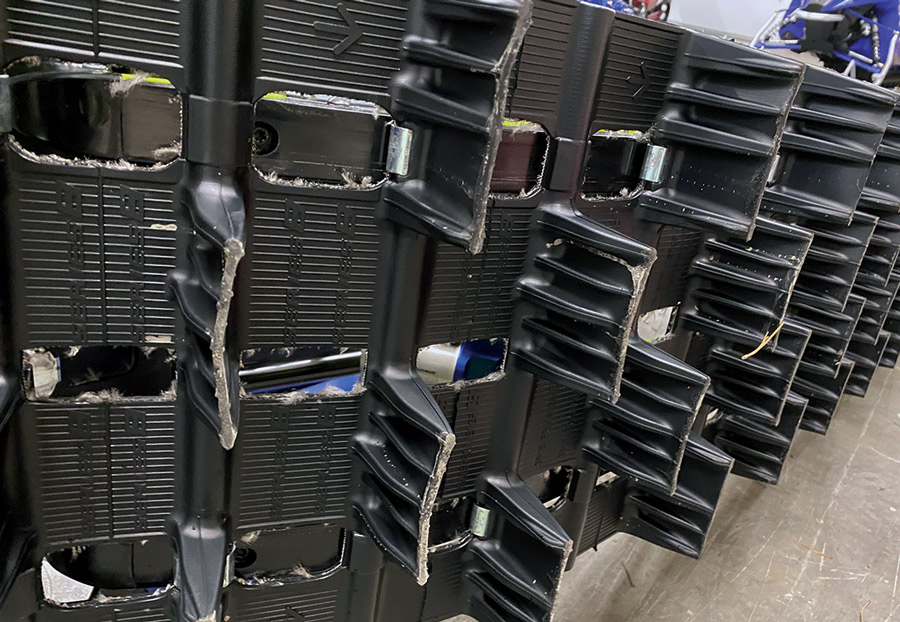

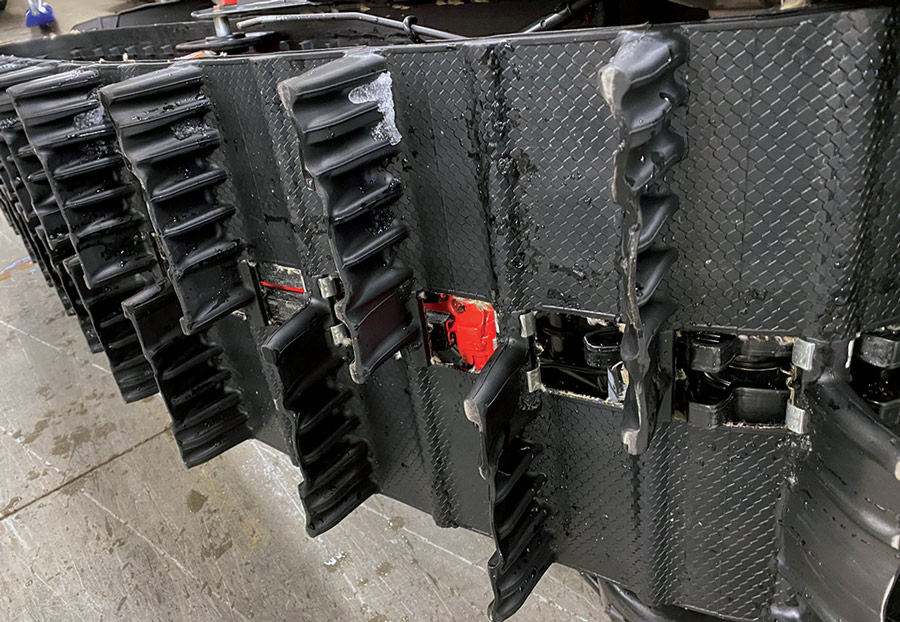
For the sidehill and wheelie footprints, the side/front of the snowmobile was elevated 12 inches and that portion of the track that still made contact with the 3-inch board was measured.
Although Ski-Doo’s extra inch of track length always stands out, it seems the Cat and Yamaha approach angle and track flex really added to some of the extra inches of flotation.
The actual weight features each snowmobile full of fuel, oil and spare belt. The entire sled is suspended off the ground by the scales. (We only weighed the 154/155 sleds but this should give you sort of an idea on where weight is located on each model.) For the front, left side and right side, each snowmobile was flat on concrete and each location was elevated 12 inches to measure the weight. If you are concerned that the three measurements equal about 20 percent more than the actual sled weight, distribution from the front and sides is shared.
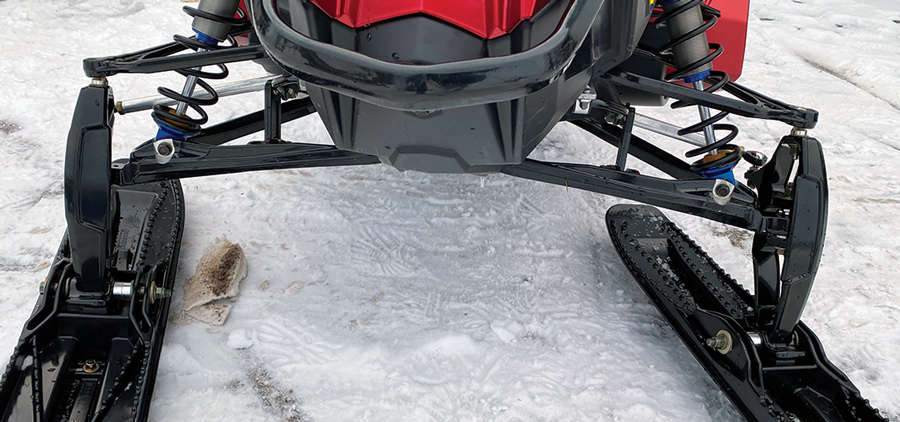

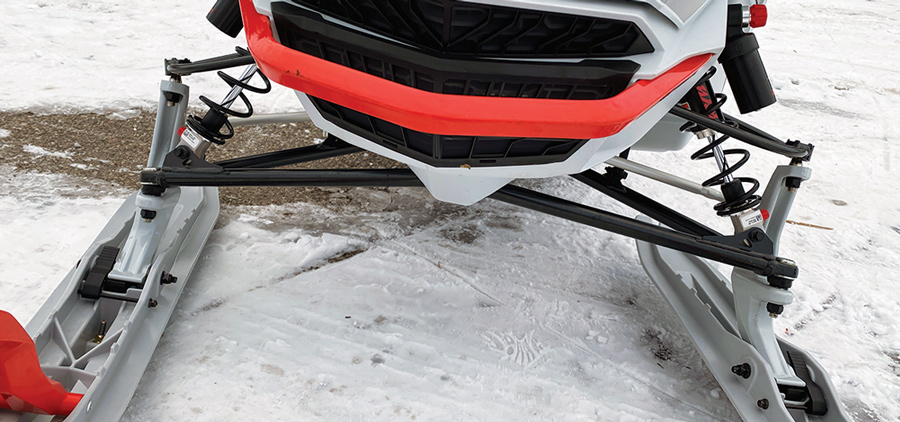





From that point on the boards, we measured to the top of the handlebars where we grip our sled (front to bar). We then repeated the process with our feet on the rear of the running boards (as when hillclimbing) to get the rear-to-bar measurement. The front-to-rear measurement shows the actual usable length of the running boards on the 154/155 sleds (the 165s would be a few inches longer). The center-of-bars-to-foot measurement shows the distance our feet are behind the vertical line of the handlebars.
